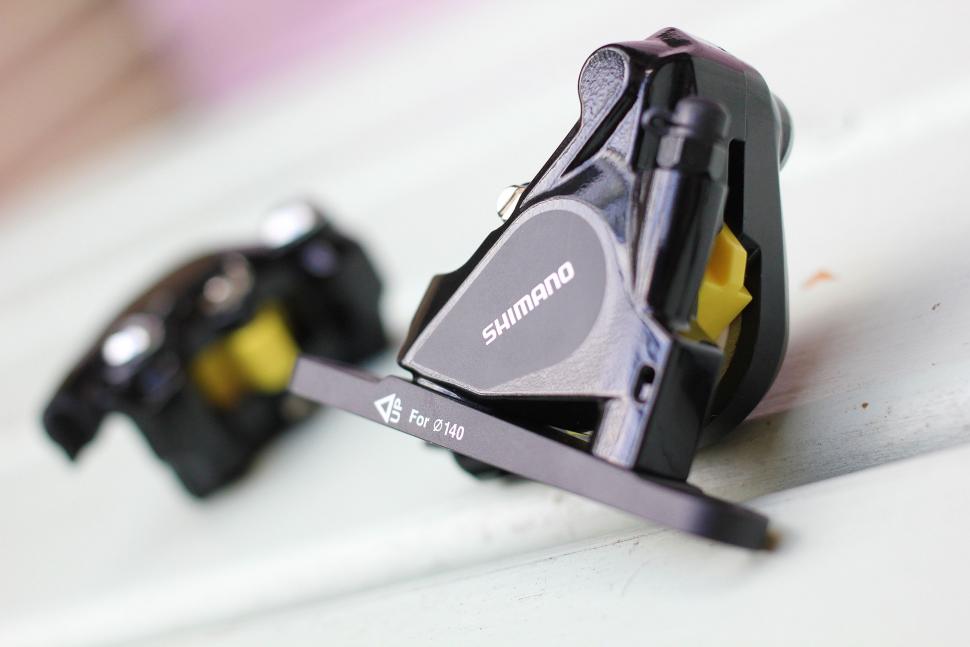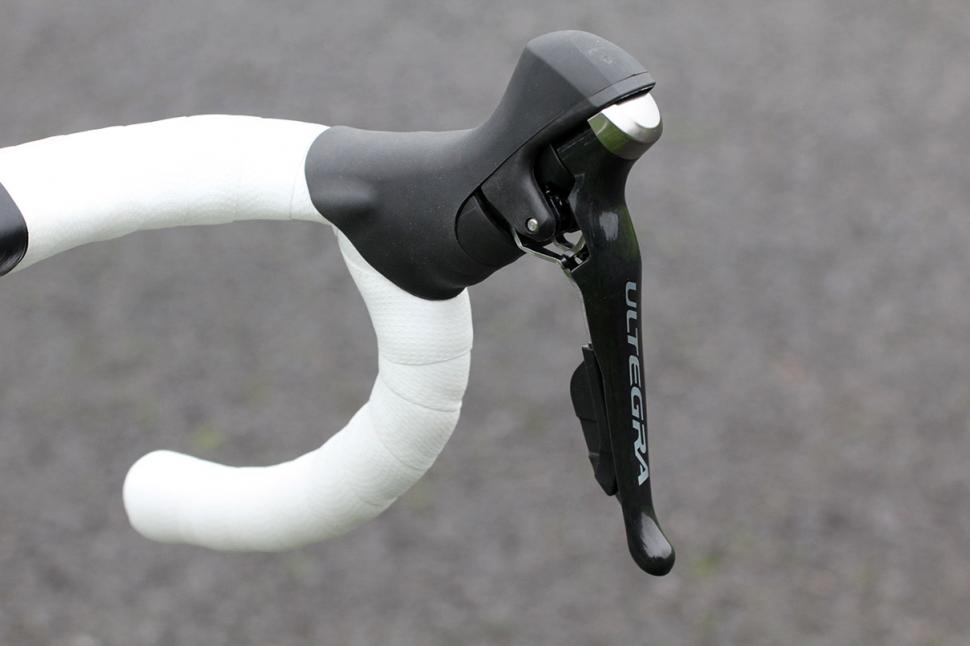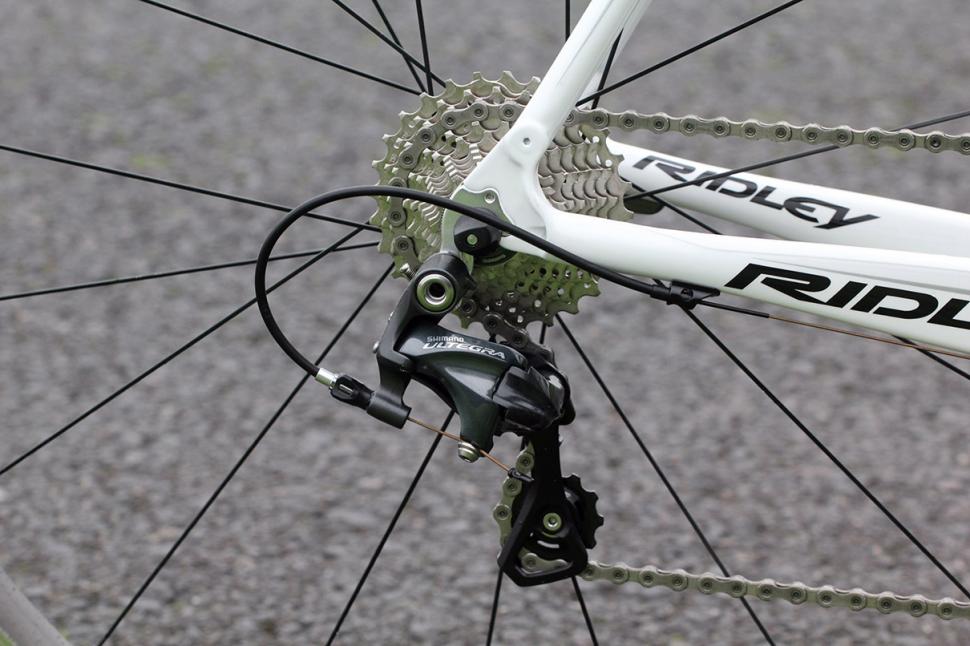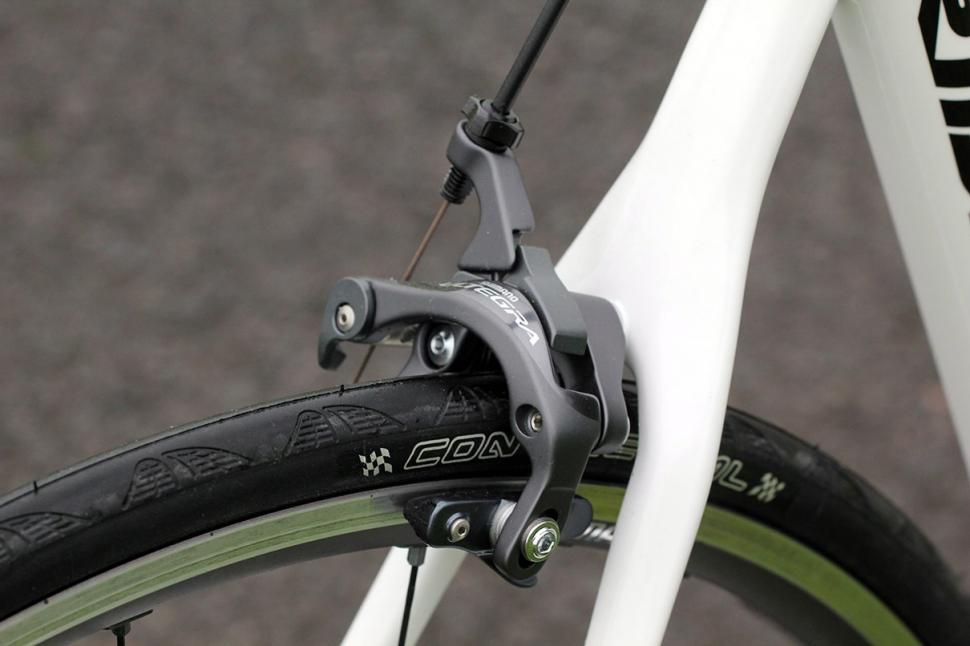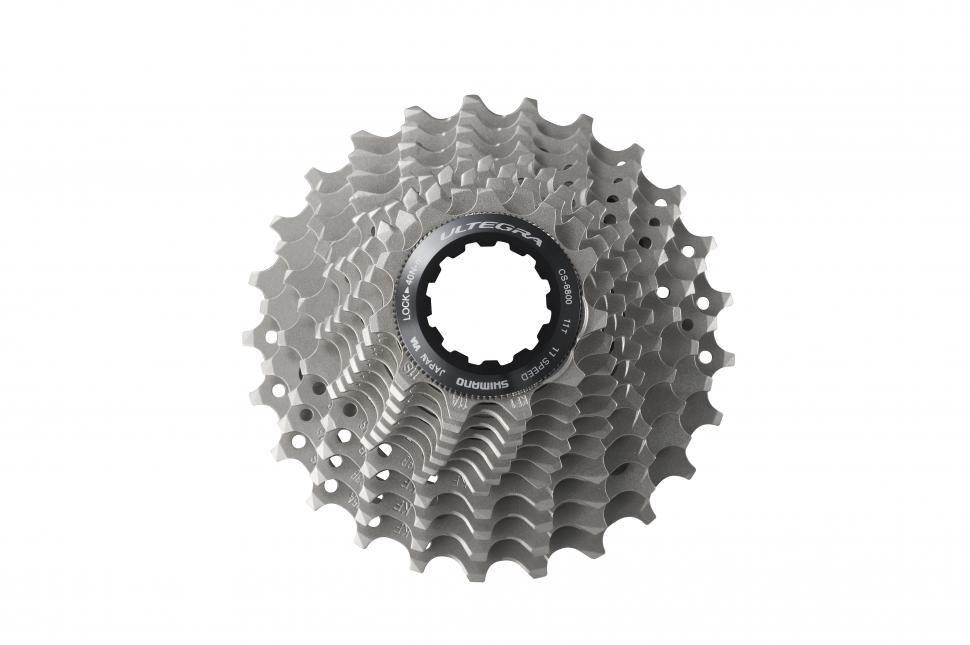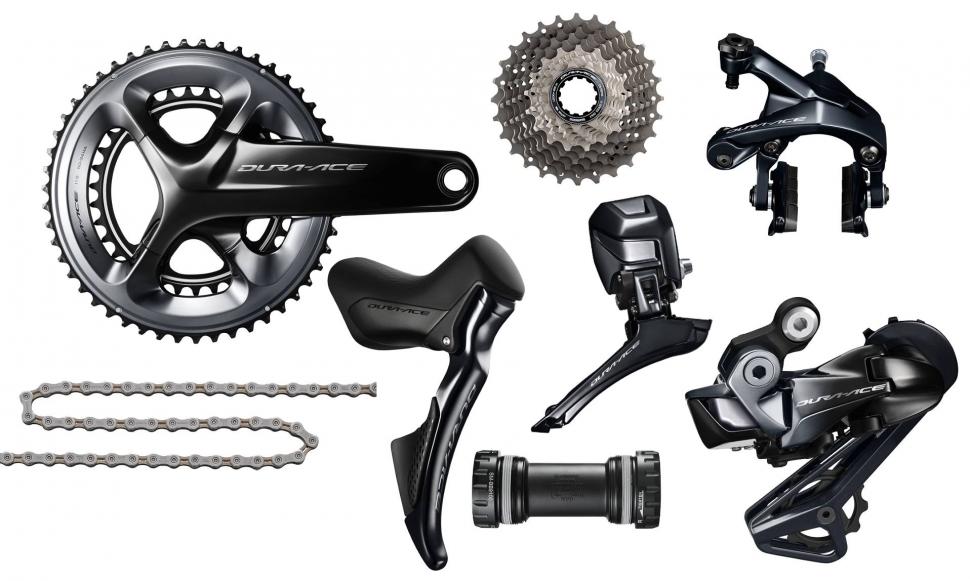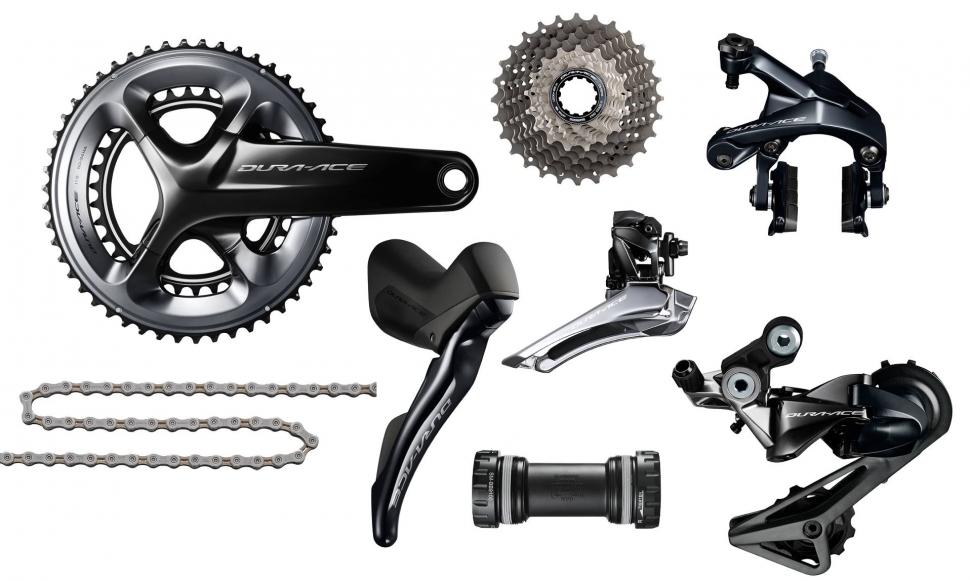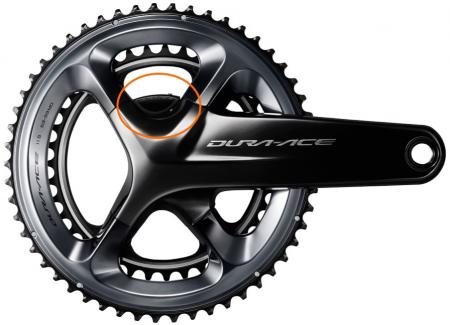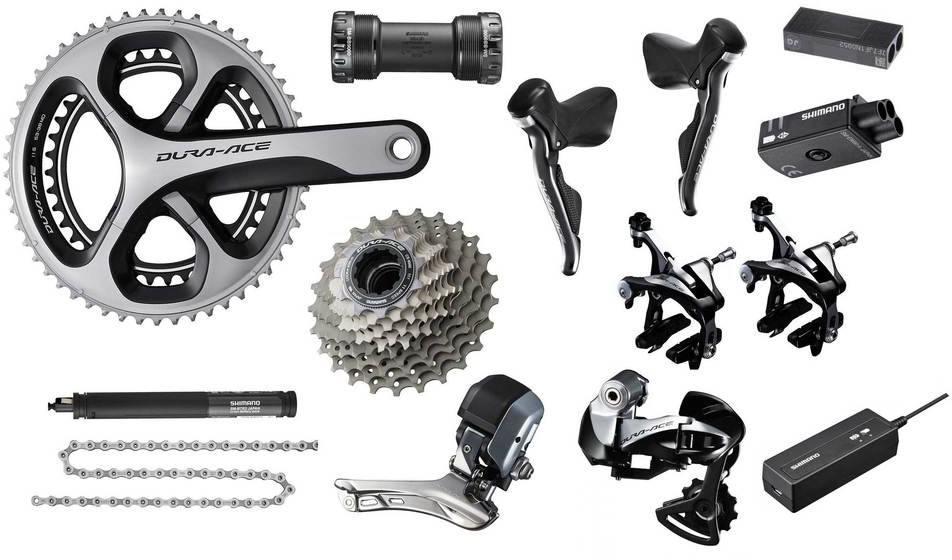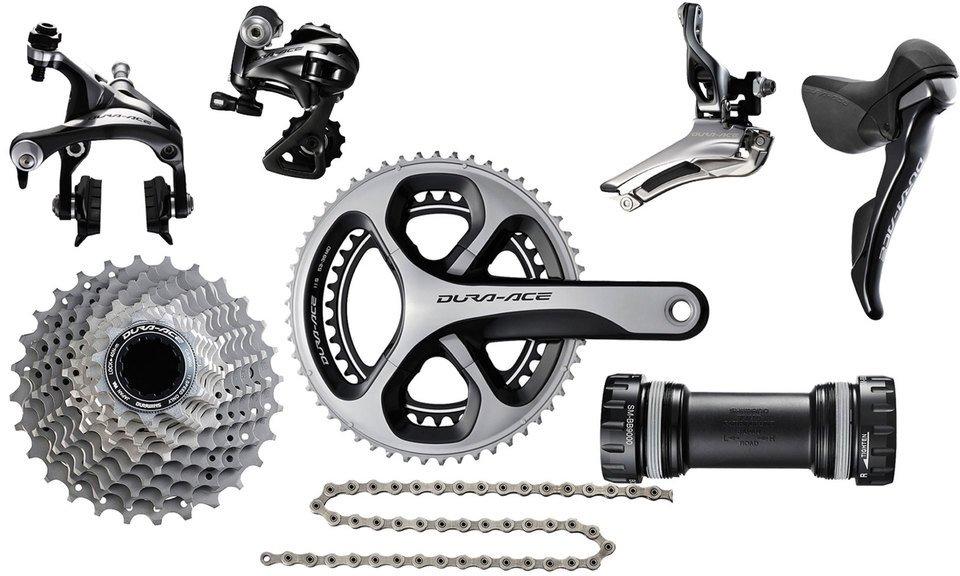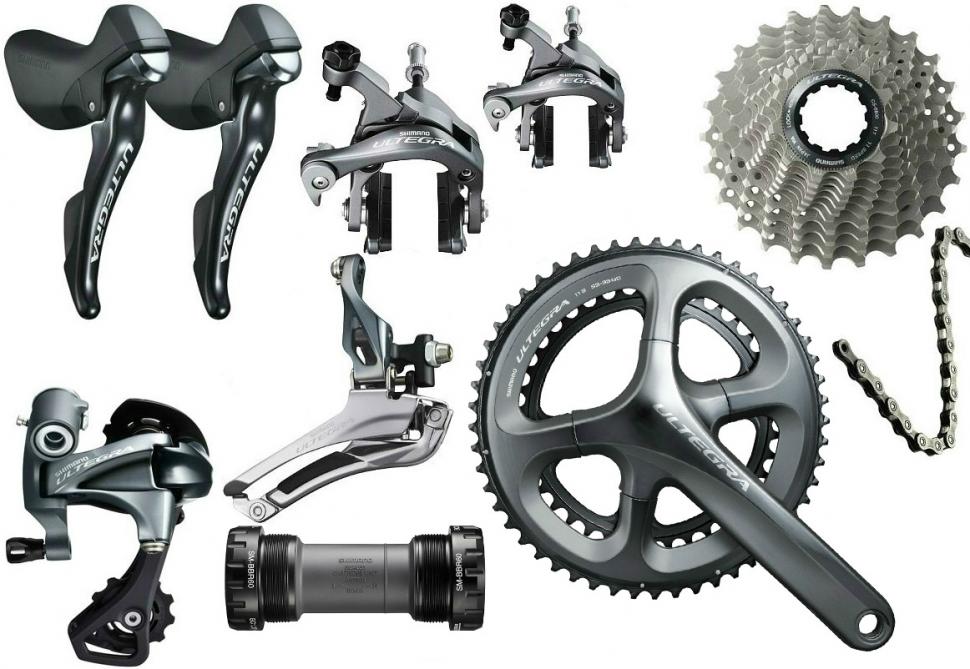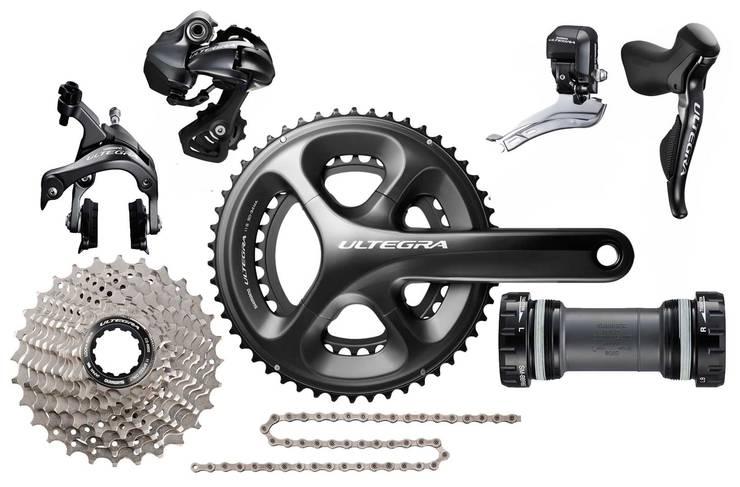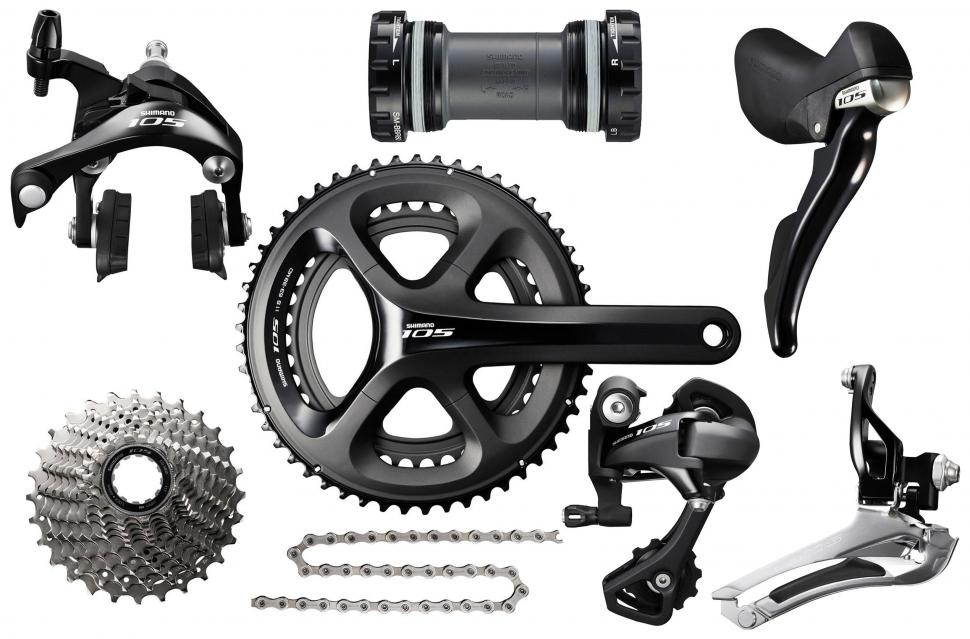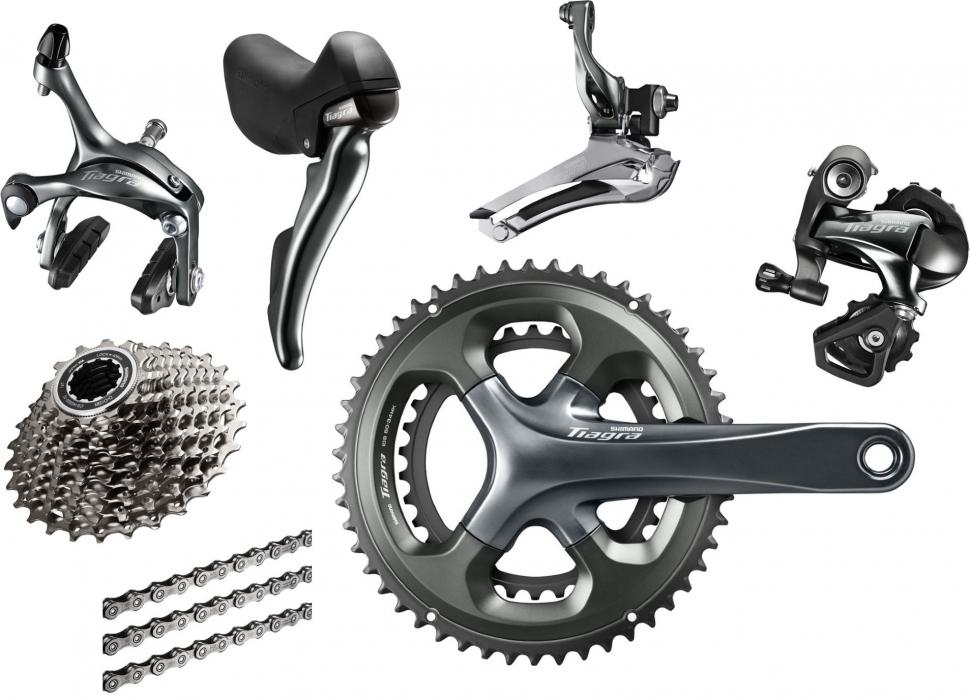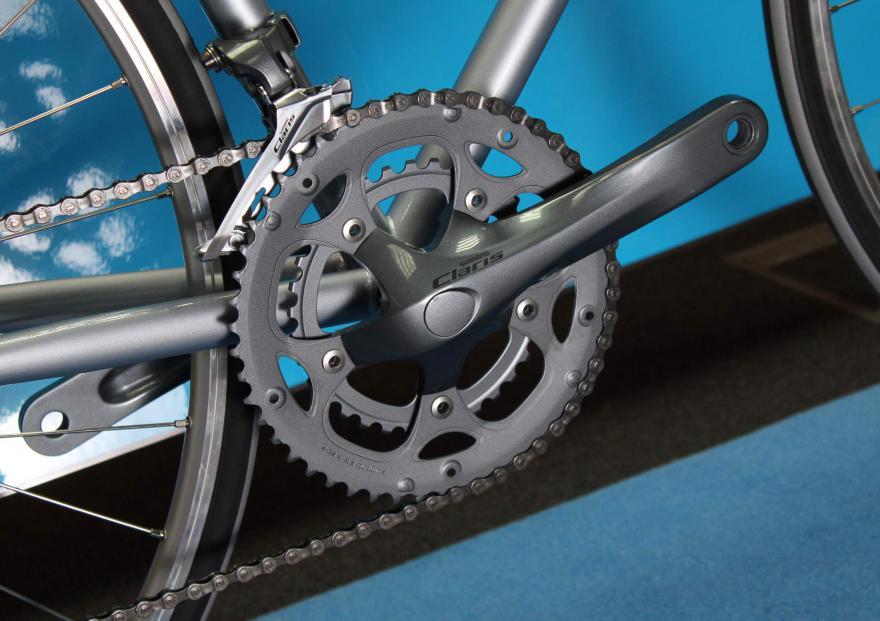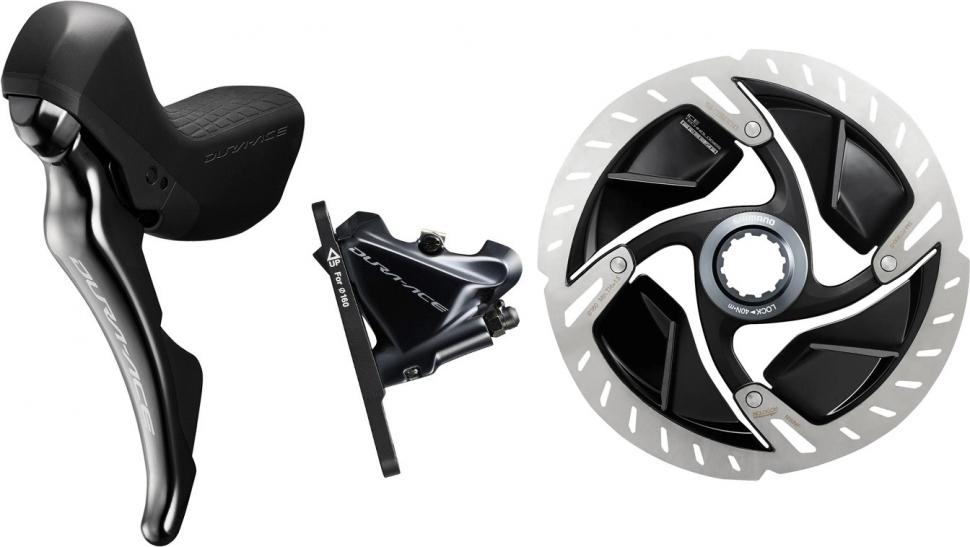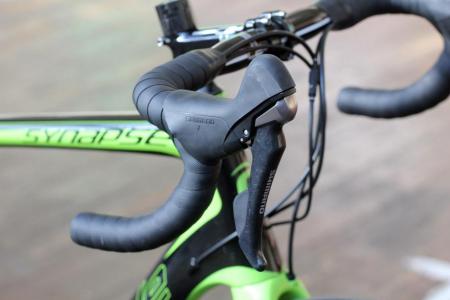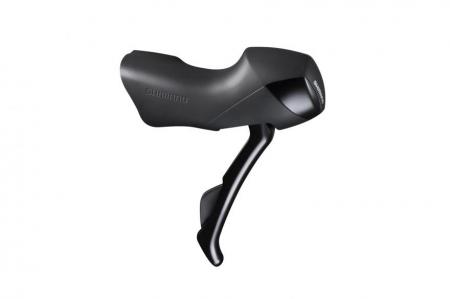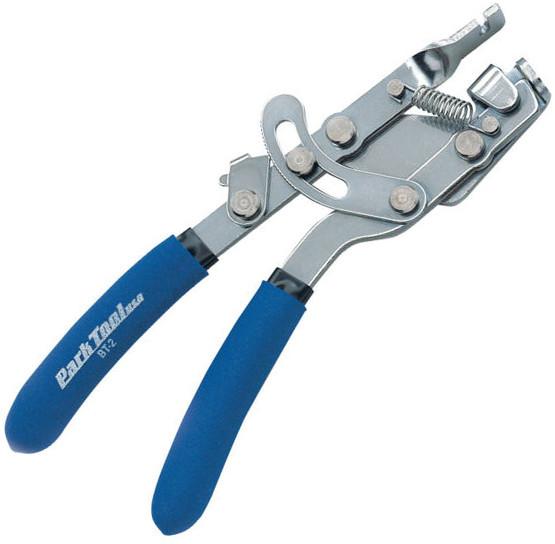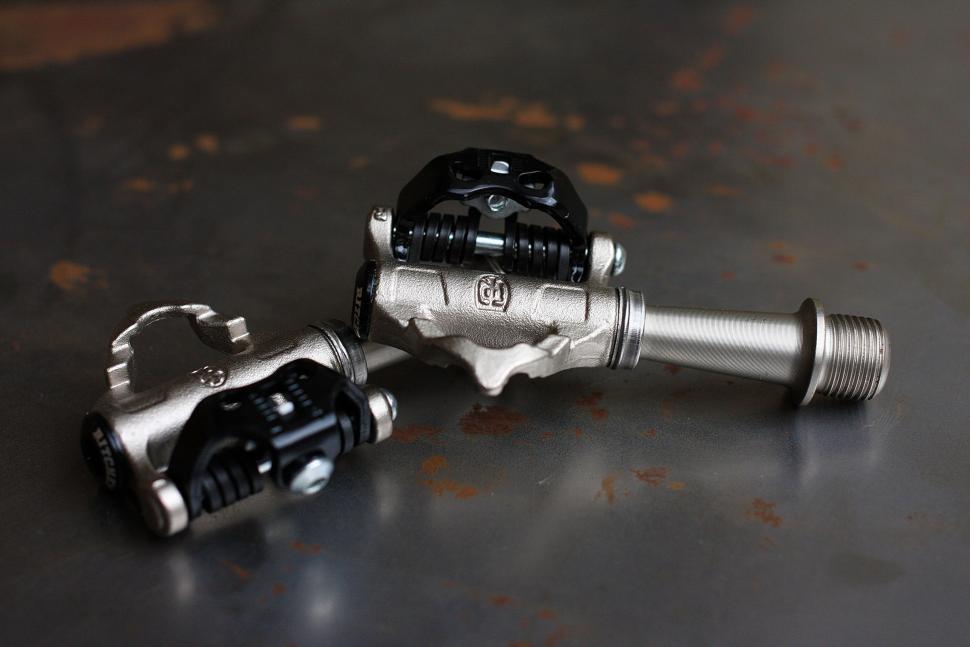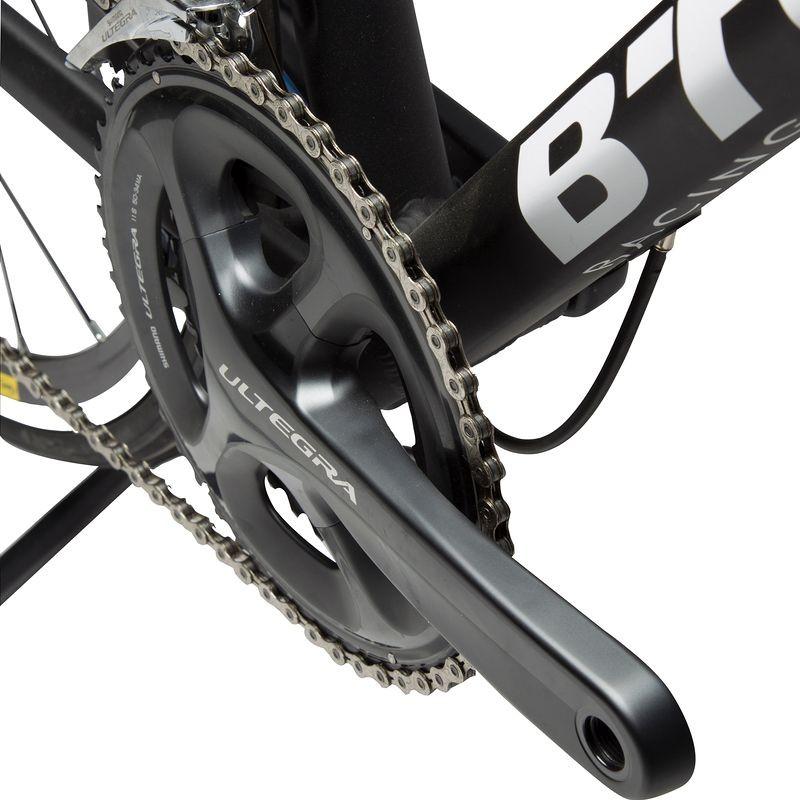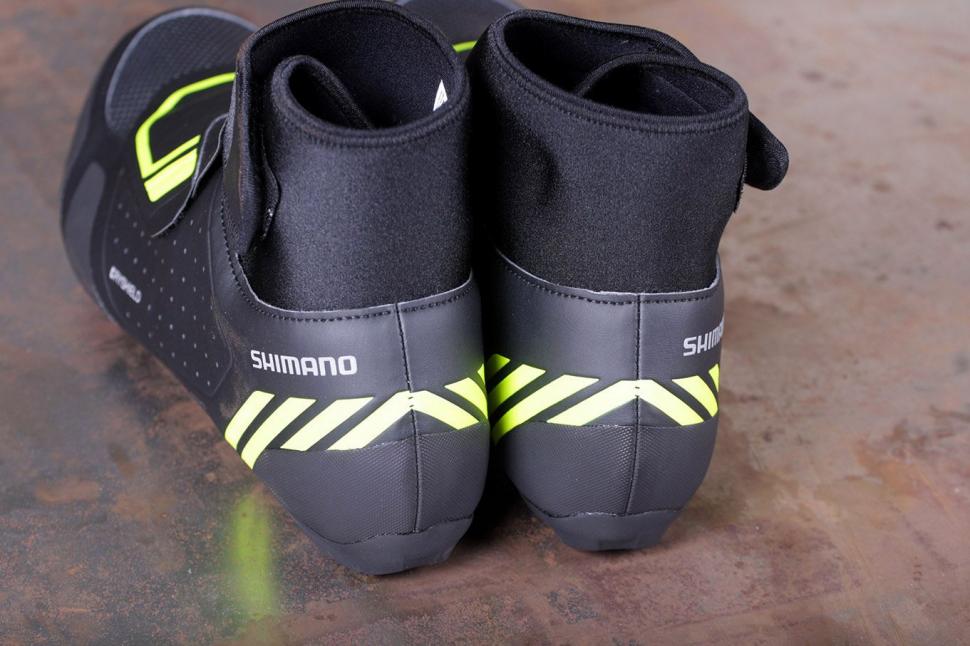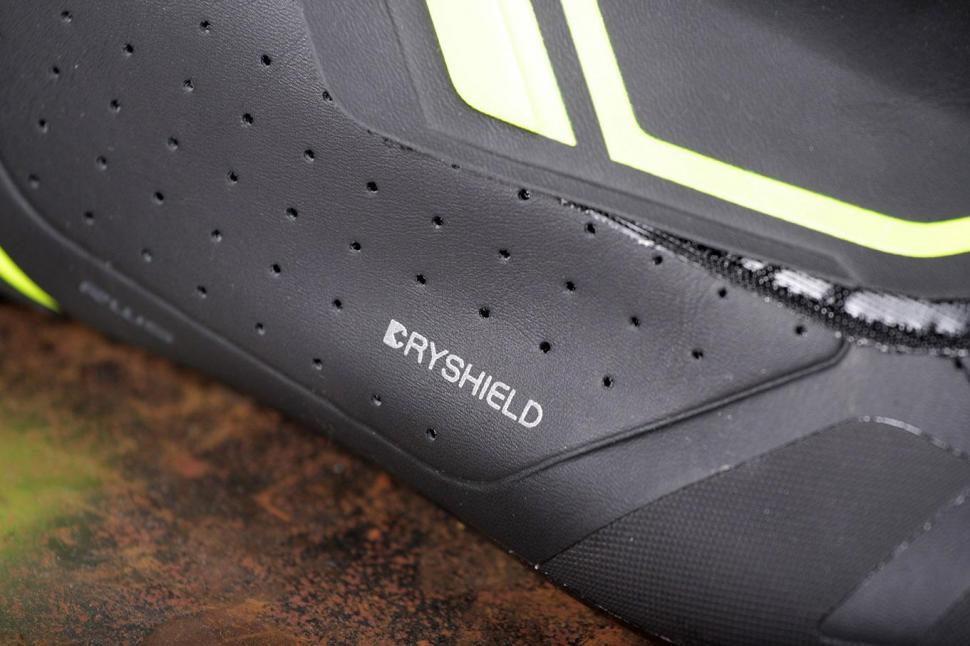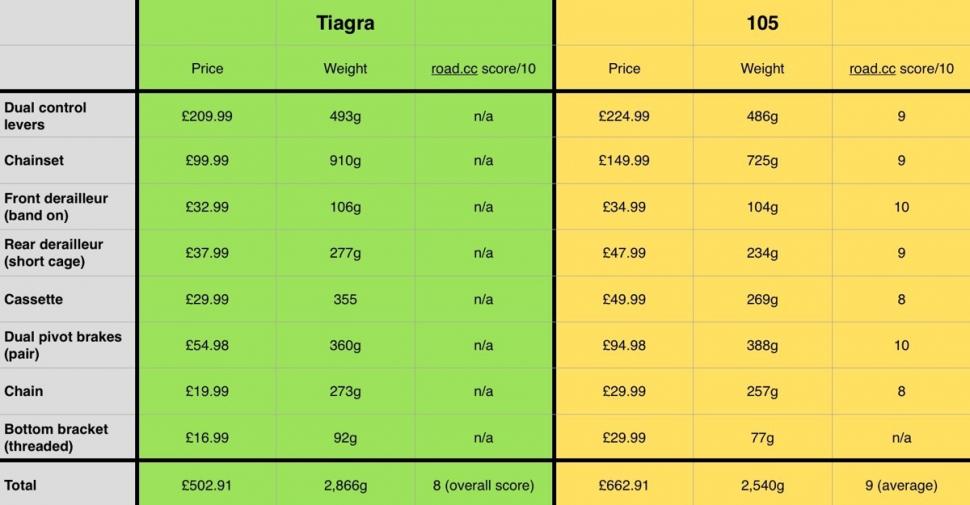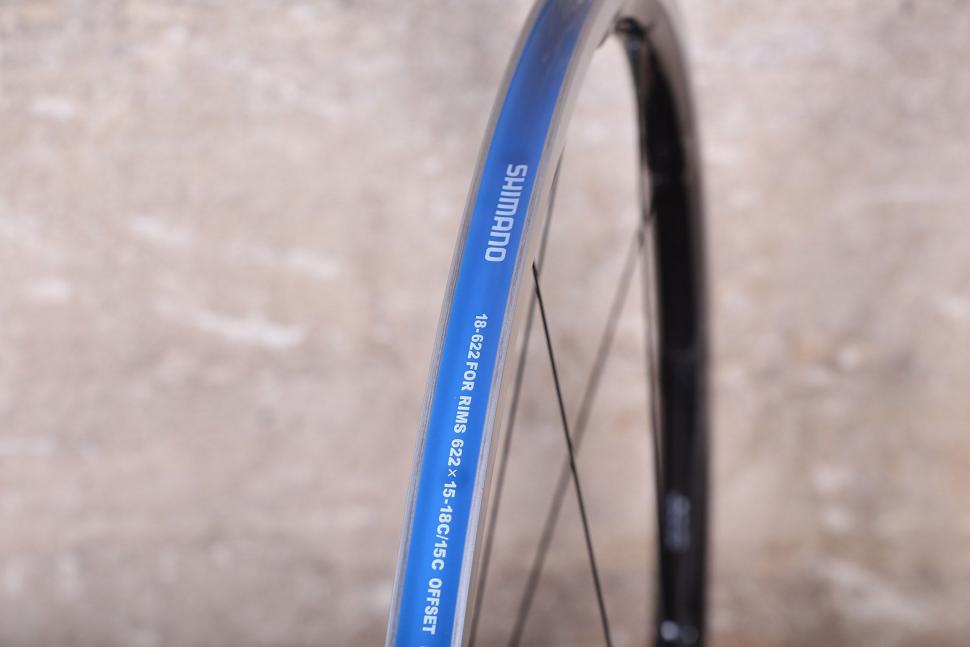Eurobike 2016 : Hope show new road calipers and hubs
Great cycling deals in the Chain Reaction Cycles Takeover
The DealCatcher's got some excellent deals on road bikes and cycling shoes in today's deal round-up straight from Chain Reaction Cycles.
We've got two road bikes in today's round-up. Fuji's Sportif 1.1 D road bike gets things moving with a 40% discount, while Cube's 2016 Attain GTC Pro Disc Road Bike has had a 20% price cut.
In terms of footwear, Shimno's R241B road shoes lead the way with a massive 66% discount, Gaerne's Bora road shoes have had a 50% price cut, and Northwave's Torpedo SRS road shoes close the DealCatcher with a 40% discount.
40% off Fuji's Sportif 1.1 D Road Bike
WAS £949.99 | NOW £569.99
Fuji's Sportif 1.1 cyclocross-ready road bike's seen a pretty hefty discount over at Chain Reaction Cycles.
We reviewed this model, and our man Dave Atkinson called it a "really good multi-purpose road disc bike that's well specced and comfortable."
Dava also gave the bike a solid 8/10, and that was at its full price of £949.
- Read more: road.cc's Fuji Sportif 1.1 2016 Road Bike review
20% off Cube's 2016 Attain GTC Pro Disc Road Bike
WAS £1499.00 | NOW £1199.99
Cube's 2016 carbon Attain GTC Pro Disc Road Bike has had a solid 20% discount over at CRC.
The 9kg bike carries Shimano's 105 drive train and Fulcrum's Racing 77 disc wheels.
Cube say that the Attain GTC is all about comfort and speed, with the frame having been updated this year to focus on reducing fatigue on long rides.
66% off Shimano's R241B Road Shoes
WAS £249.99 | NOW £84.99
Shimano's R241B road shoes offer a no-compromise attitude towards performance and premium-quality materials, at least, that's what Shimano say.
The R241Bs use premium micro-fibre leathers and multi-layered moisture control mesh to keep your feet comfortable and cool.
Heat moldable custom-fit technology is ready to give you the perfect fit, and the low-profile micro-adjust buckle and dual straps will ensure the shoes are perfectly secured for power transfer and comfort.
50% off Gaerne Bora Road Shoes
WAS £149.99 | NOW £74.99
Accorrding to Gaerne "all Gaerne shoes provide excellent breathability and a perfect climate." If we're to believe what they say about the Boras, these are no different.
And why wouldn't we believe what Gaerne have to say? Last time we reviewed a pair of the Italian brand's shoes our man John Stevenson gave them a 9/10.
The Boras you can see here include ingenious comfort features like a perforated shoe tongue to allow for better air flow, micro-perforations on the toe of the insole, and plenty of vents.
- Read more: road.cc's Gaerne Carbon G.Chrono review
40% off Northwave Torpedo SRS Road Shoes
WAS £149.99 | NOW £89.99
Our final deal of the day sees Northwave's Torped SRS shoes sitting prettily on a 40% discount.
The shoes are said to make you faster and more efficient on the road thanks to their Carbon Light sole which Northwave says is extremely stiff and as well as being incredibly light.
The slim ratchet system (SRS) from which the Torpedo SRS shoes get their name is Northwave's new micrometric buckle that offers maximum closing precision while saving plenty in the weight department.
- Read more: road.cc's Northwave Sonic 2 SRS review
Head to head: Shimano 105 v SRAM Rival 22
If you’re choosing between Shimano 105 and SRAM Rival 22 groupsets, here’s everything you need to know in order to make the right decision.
Starting right at the beginning, a groupset is a component manufacturer’s collection of mechanical parts, usually covering the derailleurs, shifters, brakes, chainset, bottom bracket, cassette and chain. Brands group these parts into various different levels. 105 and Rival 22 are the third tier road groupsets from their respective manufacturers.
Shimano 105 is much more commonly fitted as original equipment on complete bikes than SRAM Rival 22. It rules the roost on bikes priced from about £1,000. You might easily find yourself having to decide between a bike fitted with 105 and one in a Rival 22 build, though, or you could be looking to upgrade from Shimano Tiagra or SRAM Apex and want to check out the options open to you. Either way, the aim of this article is to explain the differences so you can make an informed choice.
A complete Shimano 105 groupset, available in both silver and black finishes, costs from £559 at RRP while a SRAM Rival 22 groupset is priced from £524.
SRAM Rival is also available as a 1x system with a single chainring matched up to a wide-ranging cassette. We’re not covering that here because it has no direct rival from Shimano. Just bear in mind that SRAM Rival 22 and SRAM Rival 1 are not the same thing.
We’ll go through each component in turn.
Shifters
105£179.99, Rival 22£198
In use, the biggest difference you’ll notice between 105 and Rival 22 – and between any other Shimano and SRAM groupsets, come to that – is in the way the shifters work. 
With Shimano’s design (above), you change to a larger sprocket by sweeping the brake lever inward, and you change to a smaller sprocket by pushing a lever that sits behind the brake lever. Shifting the chain between chainrings follows the same principle. It’s a very light action thanks to polymer coated cables.
SRAM uses what it calls a DoubleTap mechanism. A shift paddle located behind the brake lever handles both upshifts and downshifts. You tap it to move to a smaller sprocket, and you push it further to shift the other direction. Shifting at the front operates in a similar way.
We wouldn’t say that one system is inherently better than the other, but they are different. We’d suggest you try out both systems before making a buying decision, perhaps at a local bike shop, to see which you prefer. This will also tell you whether you find the hoods of one brand more comfortable than those of the other. You’re likely to spend a lot of your riding time with your hands resting on them.
105 provides 10mm of reach adjustment for smaller hands while Rival 22 offers individual reach adjustment of both the brake lever and the shift paddle.
Rival shifters are lighter than their 105 equivalents. When we reviewed 105 here on road.cc, our levers weighed at 490g. Rival 22 shifters are about 150g lighter.
If you go for a hydraulic brake system, the shifters will be a different shape because they have to incorporate a master cylinder. The levers of the SRAM Rival 22 Hydro system (above, £284 per wheel) are chunky, though not as large as SRAM’s original hydraulic levers, and some people just don’t like the look of the tall front end. On the other hand, the high hood can be easy to grab, especially if you're riding with your forearms parallel to the road.
We’ve not reviewed the Shimano 105 hydraulic disc brakes (£339 per wheel) here on road.cc yet, although we do have them in. The shifters (above) are more bulbous than the standard shifters, but not massively so.
Chainset
105£119.99, Rival 22 from £134
Both the Shimano 105 and the SRAM Rival 22 chainsets are made from aluminium with hollow arms to save weight (go up to SRAM Force and the cranks are carbon-fibre).

Shimano (above) now uses a four arm rather than a five arm spider to secure the chainrings, with uneven spacing between those arms. The idea is to provide the strength where it’s most needed while dropping the weight of the fifth arm. SRAM uses a five bolt system.
The Shimano 105 chainset has a reputation for being super-stiff. When we reviewed it we said, “Regardless of how much power you put through the cranks, there’s no detectable flex there whatsoever.”
Shimano lead the field here but we’ve been impressed by the SRAM Rival 22 chainset too. Our man Dave Atkinson reported, “I had no issues with derailleur rub under power which suggests [the chainset] is nice and stiff.”
You can get the 105 chainset in a standard 53/39-tooth option, semi-compact 52/36, and compact 50/34. There’s no cyclocross-specific option, though.
SRAM’s Rival 22 chainset (above) is available in 52/36, 50/34 and 46/36-tooth options. With both Shimano and SRAM, you can swap to other chainring sizes quite easily.
Shimano offers 105 cranks in 165, 170, 172.5 and 175mm lengths – which will cover the vast majority of people –while SRAM provides all of those plus 167.5mm and 177.5mm options.
The Rival 22 chainset is available in both 24mm and 30mm axle options whereas Shimano offers 24mm only. Whichever you choose, you obviously need to get the correct bottom bracket for your bike (105 £21.99, Rival 22 £29).
The 105 chainset we reviewed here on road.cc hit the scales at 737g while you’re looking at over 100g more for Rival.
Front derailleur
105£26.99, Rival 22£30
SRAM boasts that you don’t need to adjust the position of your front derailleur (below) to avoid your chain rubbing on the side plates, no matter which sprocket you’re using. This results from what it calls ‘Yaw’ technology that has trickled down from its higher end groupsets.
Essentially, the front derailleur cage rotates slightly when you shift from the small chainring to the large one, so its angle relative to the chain remains the same.
When he reviewed SRAM Rival 22, Dave Atkinson said, “It's a bit of a fiddle to set up, but once you have it dialled in it works perfectly, and I didn't have any derailleur rub at the front even when I was crossing the chain on purpose.”
With 105 you’ll sometimes find that you need to trim the position of the front derailleur as you move the chain across the cassette.
When we reviewed 105 here on road.cc, we found that the lengthened link arm of the front derailleur (above) creates more leverage and therefore less effort is required for shifting.
“Couple that with a new spring mechanism and the shifting is smooth, fast and precise,” reviewer Stu Kerton said.
There’s not much to choose between them in terms of weight, the 105 front derailleur coming in at 88g on the road.cc Scales of Truth and the Rival 22 one a claimed 89g with a chainspotter included (to stop the chain coming off the inside of the inner chainring; you don’t get one of these with 105).
Rear derailleur
105 from £36.99, Rival 22 from £46
We’ve been massively impressed by the Shimano 105 rear derailleur (below).
“The shifting is absolutely spot on… Up and down the cassette, the chain goes in a blur,” we said in our review.
We’ve not had any issues with SRAM Rival 22 shifting either. 
With both SRAM and Shimano, you need to choose the correct sized rear derailleur for the gears you are running. Shimano’s 105 GS rear derailleur and the mid-cage version of SRAM’s Rival rear derailleur (above) allow you to use a maximum sprocket size of 32-teeth.
We weighed a short cage Shimano 105 rear derailleur at 230g while the SRAM Rival 22 equivalent is a claimed 50g lighter.
Brakes
105£34.99 (each), Rival 22£68 (pair)
Shimano’s 105 twin pivot brake callipers (below) are exceptionally good, offering loads of power and plenty of control.

“Slowing rather than stopping can be achieved with just a couple of fingers applying pressure to the lever and it's easy to avoid locking a wheel,” we said in our review. “A new brake pad compound has been used, and while it's a small improvement, it does feel a little more grippy in both the wet and the dry.”
If you have a frame with direct mount points, you can use the BR-5810 versions (£39.99) built to the same SLR-EV design but with two frame mounting points rather than the traditional single.
There’s no direct mount option in the Rival 22 lineup but the dual pivot callipers come with very good SwissStop pads. Both 105 and Rival 22 are compatible with tyres up to 28mm.
The Shimano 105 brake callipers we weighed were 390g the pair while SRAM claims 300g for its Rival 22 brakes.
Both the Shimano 105 (above) and the SRAM Rival 22 groupsets include hydraulic disc brakes (see under 'Shifters', above) that are more powerful than mechanical rim brakes, and less affected by wet conditions. Obviously, you need the correct frame and fork to take these.
In terms of overall performance, they’re very similar.
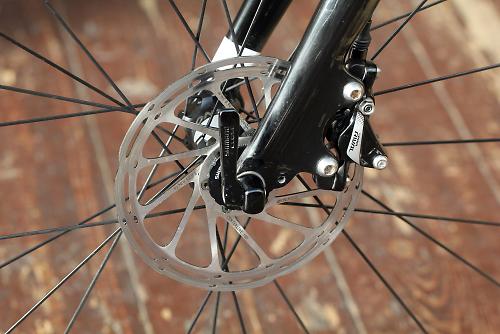
“Shimano's units feel a bit more powerful overall but the SRAM brakes (above) are a bit more progressive through their range of power, so it's swings and roundabouts,” said Dave Atkinson.
“If I had to choose one or the other, the SRAM brakes would probably edge it. They're a bit more keen to squeak when they get wet, but in my experience there's less rotor rub after heating the discs up on a long descent.”
We’ve found that bleeding the SRAM brakes is a bit more of an involved process than it is with Shimano.

SRAM also offers hydraulic rim brakes (above, £254 per wheel) that will fit to a standard (non-disc) bike, although we can’t say we’ve seen these fitted as original equipment on any bikes.
Cassette
105 from £39.99, Rival 22 from £51
Both 105 and Rival 22 are 11-speed systems, and each offers cassettes in various tooth ranges.

One SRAM cassette covers 11-36 teeth, although you’d have to use that as part of a 1x system with a specially designed rear derailleur.
You’re looking at weights from around 260g for both brands, depending on the size option you choose.
Chain
105£21.99, Rival 22£19
We’ve found the chains of both systems to be smooth and reliable, although the SRAM chain is easier to set up thanks to the inclusion of a PowerLock connecting link that doesn’t require the use of any tools. With Shimano (below), you have to use a connecting pin and a chain tool, or buy a connecting link separately.

A SRAM Rival 22 chain weighs a claimed 259g for 114 links while our Shimano 105 chain weighed 265g for 116 links, so they’re about the same.
Overall
Properly setup, both Shimano 105 and SRAM Rival 22 offer similar levels of performance to the top-level components from their respective manufacturers, it’s just that they’re a little heavier.
Each system has its strengths. We highly rate Shimano’s braking, for example, and we really like the Yaw technology that SRAM uses in its front derailleur.
By far the biggest difference that you’re likely to notice between 105 and Rival 22 is in the shifting, not in their level of performance but in the way that they’re designed to operate. You’ll probably adjust quickly to either shift system – most people do – but just make sure you’ve had a test ride before you lay down your cash.
We'd be interested to hear about the experiences of readers who have used both systems.
Head to head: Shimano Ultegra v SRAM Force
If you’re choosing between Shimano Ultegra (mechanical rather than electronic) and SRAM Force 22, the aim of this article is to tell you everything you need to know to make the right decision.
Shimano Ultegra and SRAM Force 22 are the second level road groupsets from their respective manufacturers, sitting below Dura-Ace and Red, and both are 11-speed.
If you look around you can find complete bikes equipped with some Shimano Ultegra (mechanical) components for under £1,000. The shifters and rear derailleur of Giant’s £999 Defy 0, for example, are Ultegra. That bike is built around an aluminium frame, as is the £1,400 Trek Emonda ALR 6 which has a complete Ultegra groupset.
If you want a carbon framed bike fitted with Ultegra, you’ll usually need to budget a bit more. Giant’s TCR Advanced 1, for instance, has a carbon-fibre frame and a complete Shimano Ultegra groupset for £1,499 (we're not saying than any of these bikes are the cheapest of their type).
At the other end of the spectrum, you’ll find Ultegra on bikes costing £3,000 and more. Specialized’s Tarmac Expert, for example, has a mostly Ultegra groupset, and it’s priced at £3,000.
There are far fewer complete bikes equipped with Force 22, and they tend to start at a higher price level.
We’re not covering the Ultegra Di2 electronic groupset here because there’s no SRAM Force equivalent.
SRAM Force is also available as a 1x system with a single chainring matched up to a wide-ranging cassette. We’re not dealing with that here because it has no direct rival from Shimano. Bear in mind that although some of the components are the same, SRAM Force 22 and SRAM Force 1 are different in many key respects.
We’ll go through each component in turn. All the prices shown here are RRPs provided by the brands themselves, although you can find products considerably cheaper at discount.
• Shifters
Ultegra£249.99, Force 22£303
Shifting is the area in which you’ll notice the biggest difference between Shimano Ultegra and SRAM Force 22.
With Shimano, you move the chain up the cassette by sweeping the brake lever to the side. You move the chain in the opposite direction by pushing a lever that sits just behind the brake lever. Shifting between chainrings is a similar operation. This is a system that Shimano uses across its road groupsets, from entry-level Claris to top-end Dura-Ace.
Shifting has a very light feel thanks to derailleur design and polymer-coated shift cables, and it feels almost the same whether you’re moving the chain at the bottom of the cassette or at the top.
When we reviewed the latest Shimano Ultegra 6800 groupset here on road.cc we said, “It's very hard to make an upshift fail even under heavy load, and it's nigh-on impossible with a downshift.”
The levers hoods are slim, as they are with Dura-Ace, so gripping them is easy even if you have small hands. You can also bring the levers closer to the bars via a lever stroke adjustment bolt.
SRAM has its own DoubleTap design where both upshifts and downshifts are performed using a single paddle that sits behind the brake lever. You push it a short distance to move down the cassette, and you push it further to move up the cassette. It’s a similar deal with front shifting: a short push moves you the smaller chainring, a longer push moves you up to the larger one. The alloy shift lever and the carbon brake lever are independently adjustable for reach.
Each system has its fans, and the only way to find out which one you prefer is to try them both, so we’d suggest a visit to your local bike shop or asking friends if you can borrow their bike for a trial run.
When we reviewed SRAM Force 22 we said, “Shifting is simple and precise, with a light action but positive feedback. It's more clicky than Shimano but with not quite as much feedback as Campagnolo. You're never in any doubt about whether you're shifting.
“The accuracy of the shifts is a product of all the components of the system, not just the levers, but SRAM make great play of their Zero-Loss technology which should mean all shifts are immediate. And to be fair, most of them are. It's difficult to get the groupset to miss a beat.”
SRAM has removed a bit of bulk from the Force lever, although it's still a touch chunkier than Shimano or Campag, and a bit squarer in profile. Which design you prefer is going to come down to personal preference.
SRAM gives a claimed lever weight of 307g (the pair) while Shimano claims 425g for its levers.
SRAM also provides Force 22 with hydraulic braking. Whether you go hydraulic rim brakes (£320 per wheel, includes shifter and calliper) or hydraulic disc brakes (£300 per wheel, includes shifter and calliper), the front of the levers are much taller than for the cable-operated brakes because they contain a master cylinder. These provide a good handhold, although whether or not you like the appearance is a matter of personal taste.
You can use Shimano Ultegra with hydraulic braking too. We tried out the non-series (they’re not part of any groupset) RS685 mechanical shifters/ hydraulic disc brake levers with RS785 brake callipers and found the performance to be faultless. 
“The amount of lever travel is just right, they’re easy to operate from the hoods, and you can use one finger all of the time from the drops, even when you’re panic braking because a car has pulled out in front of you,” we said.
Shimano has new RS805 disc brakes built specifically for its Flat Mount system, but we’ve not used them yet.
Shimano Ultegra is also available with electronic Di2 shifting, although SRAM Force isn’t. SRAM is, though, releasing a wireless Red eTap electronic groupset in spring 2016.
• Chainset
Ultegra£189.99, Force 22 from £220
SRAM Force cranks are made from unidirectional carbon-fibre with a machined alloy spider. Unlike Shimano and Campagnolo, SRAM has stuck with a five equally spaced bolts to hold its chainrings in place, one of those bolts behind the crank.
SRAM has stiffened up the chainrings. They're now machined from 5mm 7075-T6 aluminum and they're shaped and ramped to harmonise with the front derailleur (see below).
When he tested SRAM Force 22 for road.cc, Dave Atkinson said, “I couldn't eke any noticeable flex out of it. Shifting with the Yaw front mech (see below) was generally flawless. There's not much more a chainset can do, really. It's light, stiff and shifts well. Good work, SRAM Force chainset.”
It’s available in 53/39, 52/36, 50/34 and a cyclo-cross specific 46/36-tooth chainring options, and in 165mm, 170mm, 172.5mm, 175mm and 177.5mm crank lengths.
The alloy Shimano Ultegra chainset is available in exactly the same chainring configurations, and in the same crank lengths minus the 177.5mm. All use the same bolt spacing, so switching from standard to compact is just a case of swapping the rings and nudging your mech. With SRAM, the 53/39 chainset has a different bolt spacing from the other options.
The idea behind the unequal spacing on the four-arm chainset is that the arms are placed to deal with the stresses that a chainset endures from your pedalling. You don't apply equal pressure all the way round the pedal stroke, so by moving the arms and reducing their number by one, you get the same stiffness but for a lower weight.
The big gap between arms two and three wouldn't really work with a standard single-piece alloy chainring, as the gap is too big and the ring would flex. But the outer chainring on the Ultegra 6800 groupset is two alloy plates sandwiched together, with a hollow centre. As such it's much stiffer, and able to bridge the gap effectively.
SRAM claims a weight of 697g for a Force 1 chainset with 172.5mm cranks and 53/39-tooth chainrings (BB30 bottom bracket not included) and 715g for a GXP version. Shimano claims 765g for an Ultegra chainset (crank length not stated) with 53/39-tooth chainrings, including the bottom bracket (the BB is about 65-75g).
• Front derailleur
Ultegra From £31.99, Force 22£41
Rather than simply moving in and out, SRAM’s Force 22 Yaw front derailleur is designed to rotate inline with the chain when you shift between chainrings. This eliminates the need to trim the position of the front mech to avoid chain rub (where the chain hits the side of the front derailleur cage) when you move from one side of the cassette to the other.
The Yaw design really works. The setup still needs to be very precise, but once you've dialled it in you can go big chainring/big sprocket and small chainring/small sprocket (although chain wear is greatest whenever the chainline is at its extreme).
We’ve always found shifting between the two rings to be very good, and SRAM includes a chain catcher (to stop the chain coming off the inner ring) as part of the front mech package.
The Shimano Ultegra front derailleur has a much longer activation arm than previously to reduce the shift effort, and it features a support bolt that comes into contact with the frame to stiffen up the structure. If you have a carbon frame you'll want to cover the contact point with the stick-on alloy plate to avoid damage.
Front shifts feel light with an excellent pick-up from the chain and the chainring ramps on the upshift.
SRAM claims a weight of 79g for a braze on front derailleur, plus 10.2g for the chain spotter. Shimano claims 89g for the Ultegra front derailleur.
• Rear derailleur
Ultegra From £59.99, Force 22£76
The rear shifts you get with Shimano Ultegra are excellent, the derailleur working with polymer-coated cables that reduce the friction to offer light-action gear changes.
Shimano offers the rear derailleur in two cage lengths, the shorter of which allows you to use a maximum sprocket size of 28-tooth. With the mid-cage version you can go up to 32-tooth.
The SRAM Force rear mech, which comes with a carbon outer cage, is also available with two cage lengths, the longer one of which can handle a 32-tooth sprocket.
When we reviewed it, we said, “Force 22, like all of SRAM's road groupsets, uses their Exact Actuation technology. Put simply, this means that for every 1mm of cable that gets pulled through the shifter, the derailleur cage will move 1mm as well. Both Shimano and Campagnolo use a higher ratio, pulling less cable to get the same amount of movement.
“Does it make a difference? Well, in theory it should make the SRAM system a bit more forgiving of tiny changes in the length of the cable run caused by the various bits settling into their stops, and each other. In practice, I can't say I've found it noticeably better in that regard.”
The Force rear derailleur goes about its business with quiet aplomb. Missed shifts have been few and far between whenever we’ve used it.
SRAM claims a weight of 178g for the short cage Force 22 rear derailleur, and 187g for the mid-cage version. Shimano claims 195g for the short cage Ultegra rear derailleur, and 207g for the mid-cage model.
• Brakes
Ultegra From £54.99 (per brake), Force 22£110 (per pair)
SRAM makes its Force mechanical brakes to a dual pivot design, and uses SwissStop pads. The brakes are lightweight and good looking, and that they work well.
“They're very good,” we said in our review. “They have plenty of power and the modulation, and the feel at the lever is excellent. The indexed quick release lever is good too. But in terms of all-out performance, they're a shade behind Shimano at the moment.”
Shimano’s brakes are dual pivot as well, but instead of using the brake bolt as a pivot, the Ultegra units have two symmetrical pivots that are attached to a carrier that then mounts to the normal point.
Shimano uses a very good brake pad compound and polymer-coated cables to provide an excellent performance.
“The braking effort to stop you is reduced, and that means less arm fatigue on long rides,” we said in our review. “Haul them on and they're both powerful and controllable. The improvement over the previous Ultegra callipers is especially noticeable in the wet, which is possibly down to the new brake compound rather than the redesigned body, but everything works very well together here.”
We rated them 10/10.
Shimano also offers a direct mount option (£59.99 per brake) where the arms attach directly to the frame to increase power, save weight and, in many cases, reduce drag. You need to have a bike frame that is especially designed to take these.
SRAM claims a Force 22 brake weight of 280g (pair), while Shimano claims 317g for its Ultegra brakes.
SRAM Force 22 is also available with hydraulic braking (see ‘Shifters’, above) for improved power and control, especially in wet conditions. The disc brakes use 18mm pistons front and rear, and SRAM recommends 160mm rotors for the road. 
When we used Shimano’s non-series RS685 levers (which you can use with any of Shimano’s 11-speed groupsets) with RS785 callipers, we said, “The brakes are powerful, strong and, really they just feel fantastic… You can splash through puddles and ride through mud, caking the rim, but the disc brakes will give you the same predictable braking performance.”
• Cassette
Ultegra From £59.99, Force 22£80
SRAM offers its Force 22 cassette in several different flavours: 11-25, 11-26, 11-28 and 11-32-tooth (you need to get the appropriate rear derailleur to handle the cassette you’re using). There’s even an 11-36 one, but you need to use that as part of a Force 1 (single chainring) system.

All the cassettes use an alloy/steel spider for the big sprockets with loose steel smaller sprockets and plastic spacers.
Shimano offers 11-23, 11-25, 12-25, 11-28 and 11-32-tooth Ultegra cassettes, and they work splendidy.
SRAM claims a weight of 231g for the 11-25-tooth cassette; Shimano claims 212g for an 11-23-tooth cassette.
• Chain
Ultegra£27.99, Force 22£37
SRAM's 11-speed PC-1170 chain uses hollow pins to save a bit of weight, and it comes with a Powerlink connector that makes fitting a whole lot easier, although it's a one-time-only unit. 
We’ve always found SRAM chains to give a decent service life.
Shimano offered directional chains for a couple of years, but we're back to symmetrical now so it’s impossible to get them the wrong way round.
The chain has a surface coating called Sil-Tec that’s designed to reduce friction between all the moving parts, and the chain wear is good.
Like SRAM’s chain, the Shimano one has hollow pins, but rather than using a tool-less connector it joins with an extended pin that you put in place with a chain tool before snapping the end off. If that’s not for you, you can use a third party connecting link.
Shimano claims a weight of 257g for 116 links while SRAM claims a weight of 256g for 114 links.
• Overall
Both Ultegra and Force 22 perform as well as the top end groupsets in their respective ranges, Dura-Ace and Red. The differences are that they weigh a touch more – not loads more – and they lack a little of the prestige, if that’s the sort of thing that interests you. Assuming you can live with that, you can save yourself a lot of money by opting for Ultegra or Force 22, because both Shimano and SRAM really make you pay a lot for their peak products.
When choosing between Ultegra and Force, the biggest factor you need to consider is the shifting: which system do you prefer?
Beyond that, we’d say that Shimano cable-operated rim brakes outperform SRAM’s, but if you’re after hydraulic braking there’s less to choose between them.
Please let us know your thoughts, particularly if you have experiences of both systems.
Your complete guide to Shimano road bike groupsets
A groupset is a collection of bike components designed to work together. These days it usually means the gears and brakes on your bike. The term once included the hubs and headset too, but threadless headsets knocked the traditional groupset makers — Shimano and Campagnolo — out of the market. Nevertheless, the groupset is where a lot of the money in a new bike goes.
Japanese company Shimano is the most popular groupset manufacturer with a range of groupsets at different prices. It’s constantly updating the groupsets too, with the newest features debuting first on its top-end groupset, Dura-Ace, before eventually filtering down through the range.
Whether you’re buying a new bike, or looking to build one from scratch, it’s good to know what your options are. The more expensive groupsets are lighter and usually offer smoother gear shifting and superior braking performance, and you get more gears and with the more expensive groupsets, 11-speed on Dura-Ace, Ultegra and 105, down to 8-speed on entry-level Claris.
Here’s an overview of the entire lineup, with the most expensive at the top of the list:
- Shimano Dura-Ace 9070 Di2
- Shimano Dura-Ace 9000
- Shimano Ultegra Di2
- Shimano Ultegra
- Shimano 105
- Shimano Tiagra
- Shimano Sora
- Shimano Claris
The range includes six mechanical groupsets, using cables to operate the front and rear derailleurs, and there are two electronic groupsets. First introduced in 2011, electronic groupsets have proved to be extremely popular, with precise gear changes, long battery life and good durability. Whether you choose mechanical or electronic comes down to budget and personal preference.
At the moment (early October), both the 2017 Dura-Ace 91XX and the previous 90XX components are listed by retailers, though it looks like we're still a few days off actually being able to buy the new parts. We've therefore covered both here.
>>Read more: Why you should switch to electronic shifting
Shimano Dura-Ace 9150 Di2
RRP: £3097.99
Shimano's flagship component group gets a major facelift and some new options for 2017. The mechanical and Di2 electronic groups share the same chainset, brakes and other non-shifting components, but with Di2 you get switches on the brake levers, derailleurs with built-in motors and the battery, wiring and control box that ties it all together.
The major new feature of Di2 is Synchronized Shift, a technology borrowed from Shimano's mountain bike Di2 components. Rather than buttons controlling front and rear derailleurs independently, one pair of buttons moves up and down the gear ratios, making shifts at the front or rear derailleur, or both, as necessary.
Shimano says this is “designed to simplify gear choice and reduce decision making in racing situations.”
There are two modes. If you go for the Full Shimano Sychronized Shift, the front derailleur reacts based on the rear derailleur’s shift action. You don’t need to use two separate shifters, you just use one. Press one button and the gear will get harder to turn, press the other button and the gear will get easier. If that requires a front shift, the system will take care of that automatically; you don’t need to worry about it.
If you go for Semi Shimano Synchronized Shift mode: the rear derailleur reacts based on the front derailleur’s shift action, shifting to the next most appropriate rear gear when the rider makes a front shift.
A new junction box is not only very tidy — it can be hidden inside the end of the handlebar — it provides wireless ANT Private connectivity to third-party devices. The system also offers a Bluetooth connection to phones and tablets running Shimano's E-Tube software so you can program the shifting behaviour.
Buy if: You want the state of the Shimano art.
Read more: New Shimano Dura-Ace R9100: 5 key innovations
Shimano Dura-Ace 9100
RRP: £1874.99
If your budget won't stretch to the electronic version of Dura-Ace, the mechanical version is by no means second best — it's still a superb ensemble. The 9100 group offers perhaps the widest range of options Shimano has ever offered in road bike components, including a power meter, hydraulic disc brakes, a wider gear range and an increased selection of wheels.
The 9100 group features new derailleurs too, using design features that originally appeared on Shimano's mountain bike parts to reduce the chance that the rear mech will get damaged in a crash. Just one rear derailleur will handle any gear system you choose, including the new 11-30 cassette.
Shimano's rival SRAM has offered power meters since it acquired Quarq in 2011. With the 9100 group Shimano adds a very tidy power meter to its collection. How tidy? You can see in the pic to the right that the electronics are barely visible:
The inclusion of hydraulic disc brakes in the Dura-Ace line shows how completely Shimano has embraced road bike discs. Previously Dura-Ace equipped bikes with discs had to use Shimano's non-series brakes and levers; now they match.
If you're using rim brakes, the 9100 Dura-Ace calipers have been subtly redesigned so they'll accommodate 28mm tyres.
Finally, there's a big range of wheels in the latest Dura-Ace line up. The new C40 and C60 wheels have 28mm wide carbon fibre rims that are 40mm and 60mm deep, respectively.
Buy if: You're racing or doing mega distances and you want the best mechanical shifting.
Read more: Shimano reveals new top-end R9100 Dura-Ace groupset
Shimano Dura-Ace Di2 9070
RRP: £2,999.99
This is Shimano’s most expensive groupset. Shimano Dura-Ace Di2 has become hugely popular and most professional teams use it. It's favoured by many well-funded amateur racers and sportive cyclists too, or anyone who wants the best money can buy. The groupset uses the same chainset, chain, cassette, brakes and bottom bracket as regular Dura-Ace, but the shifters and front and rear derailleurs are different.
Dura-Ace Di2 uses a similar shifting design to mechanical, but instead of pushing two levers, you push two buttons positioned next to each other. If you want to move two or more sprockets at a time, rather than swinging the lever further like you do with a mechanical system, you just keep the button pressed down.
If you want, you can customise the shift function. Plug the groupset into a computer and you can configure the shift buttons in any way you want. You can personalise the speed of the shifting, the number of sprockets that will be shifted, and even control the rear derailleur with the left hand. An advantage of Di2 is the option of adding additional shifter pods, satellite shifters that can be fitted to the tops or the drops.
The latest Di2 groupset features an internal battery, which you can hide inside the seat post. Worried about it going flat? It’s good for a claimed 2,000km between charges. That’s lots of riding. Apart from charging the battery, there is very little to go wrong with Di2, and it’s actually really well suited to winter riding and long distance rides through demanding conditions.
>>Read our review of the Shimano Dura-Ace Di2 9070 11-speed gear system
Shimano Dura-Ace 9000
RRP: £1,499.99
Dura-Ace mechanical is still a very good groupset, so don’t overlook it too hastily. It’s probably the best ever mechanical groupset (SRAM and Campagnolo fans might disagree), with super slick gear shifts and really powerful brakes.
Dura-Ace was the first Shimano groupset to go to 11 sprockets, causing some controversy at the time, but widely accepted now. Shimano has evolved the ergonomics of the hoods (the rubber part at the top of the brake lever) over the years and this design has trickled down through the ranks.
Review: Shimano Dura-Ace 9000 groupset
Buy Dura-Ace if you want the lightest pro-level groupset
Shimano Ultegra 6800 and Ultegra Di2 6870
Shimano Ultegra 6800
RRP: £999.99
Shimano Ultegra 6800 Di2
RRP: £1,999.99
If you want high performance without the hefty price tag of Dura-Ace, then Ultegra is probably the pick of the range. Since the 6800 update, the gap between the two has been narrowed, and it shouldn’t be overlooked too quickly if you want high performance and decent weight components.
It’s a favourite with amateur racers because the weight penalty is minimal, especially if built onto a decent carbon fibre frame, and the performance is nearly identical. You still get the carbon fibre brake lever as well like you do on Dura-Ace, and the cranks, brakes and derailleurs share the same design as Dura-Ace.
Dura-Ace is really aimed at racing bikes, making Ultegra a more versatile groupset. With a range of chainring and cassette options, it can be fitted to all sorts of bikes, from racing cycles to touring and adventure bikes. From an 11-23t cassette and 53/39t chainset for the racers to an 11-32t cassette and 50/34t compact chainset for sportive riders, it covers a lot of uses.
The new chainset uses the same spider design so changing rings is easy, so you could easily swap rings from racing to riding in the mountains without removing the cranks. The rear derailleur comes in short- and mid-cage lengths and can work with up to a 32t sprocket on a wide-range cassette. Cassette options range from 11-23t right up to 11-32t, with plenty of options in the between the two extremes.
Ultegra is now available with a Di2 option as well and is Shimano’s most affordable Di2 groupset, and there is no 105 Di2 on the horizon at the moment. Like Dura-Ace, both Ultegra groupsets are 11-speed.
- Review: Shimano Ultegra 6800 groupset
- Shimano Ultegra Di2 6870 11-spd groupset
Buy Shimano Ultegra if you want performance without the price tag of Dura-Ace
Shimano 105 5800
RRP: £559.99
Shimano 105 probably used to get overlooked in favour of Ultegra, but the latest version brings it into line with the visual appearance first introduced on Dura-Ace. So now it’s a very good looking groupset, but more than that, it’s a stunning performance groupset for the money. It’s a bit heavier than Dura-Ace and Ultegra, but the performance runs both very close, with good shifting and braking.
105 also received an upgrade to 11-speed when the latest version was released in 2014. It was 10-speed previously. It’s heavier than Ultegra, but you have to be a weight weenie to worry about that. Incredibly good performance for the money, and with shifting performance so close to the performance of Ultegra, choosing between the two might simply come down to money.
You see a lot of entry-level and mid-range bikes specced with Shimano 105, it’s the workhorse of the Shimano groupset range, and features on bikes covering a really wide price band. Sometimes it gets mixed with other branded parts to meet key price points, but a full 105 groupset is definitely something to look for, as there really is no weak part of the groupset.
- Review: Shimano 105 5800 11-speed Groupset
Buy Shimano 105 if you want the most affordable 11-speed groupset
ShimanoTiagra 4700
- RRP: £449.99
- Best online price: Ribble Cycles £229.95
Shimano’s fourth-tier groupset was updated for 2016. The changes bring it the appearance of Shimano 105 above it, with the same four-arm crankset and new shifters, with the gear and brake cables hidden underneath the bar tape. As well as the drop-bar kit, Tiagra will be available with flat bar levers and shifters, so expect to see it on commuter and city bikes as well.
Tiagra retains the 10-speed configuration, though, and that could be a deciding factor if choosing between Tiagra and 105. There’s no 53/39t chainset option for Tiagra either. Shimano reckon that most people buying a Tiagra-equipped bike probably won’t be racing it and won’t need the really high gears. The 52/36t, 50/34t and 50/39/30t triple chainset options still provide plenty of range, and 52/36t is just fine for most racers.
- Shimano Tiagra 4700 first ride
Buy Shimano Tiagra if you want good value and performance, and don’t mind not having 11-speed, but for another £100 (less if you shop around) you can upgrade to 105...
Shimano Sora 3500
- RRP: £374.99
- Best online price: Ribble Cycles, £196.95
Underneath Tiagra is Shimano’s Sora groupset, against which it does look a bit dated (we wouldn’t be surprised if an update is on the way soon). It’s a 9-speed groupset, but it’s still fantastic groupset and does 90% of what the more expensive groupsets do.
You get proper Dual Control gear shifters, with the brake lever changing down the cassette and the smaller lever changing to a higher gear. That’s essentially the same system as used to be on Dura-Ace a few years ago. You have double and triple chainset options, and the rear derailleur will accommodate an 11-32t cassette along with a 50/34t compact chainset.
Other similarities with the more expensive groupsets include the Hollowtech 2 bottom bracket, with the bearings sitting outboard of the frame.
- Review: Shimano Sora 3500 groupset
Buy Shimano Sora if you want performance and value
Shimano Claris 2400
- RRP: £306.69
Claris is Shimano’s most affordable road bike groupset and is what you can expect to see on sub-£500 road bikes. The most recent update to the groupset was in 2013, when it received the same Dual Control combined brake/gear levers as Sora above it, with the downshift behind the brake lever rather than a thumb button. Claris really does have the quality feel of the more expensive Shimano groupsets.
It’s an 8-speed groupset and is aimed at beginner and new cyclists, and so you have triple chainset (53/39/30), compact(50/34) and cyclocross (46/34) chainset options, along with an 11-32t cassette. Getting up climbs won’t be a problem with the lowest gearing available with Claris. The chainsets use the older Octalink bottom bracket standard.
- New Shimano Claris groupset in detail
- Review: Cube Peloton Claris (2015)
Buy Shimano Claris if you’re on a budget
Hydraulic disc brakes
We can't have a guide to Shimano groupsets and not mention the brakes. Shimano offers a choice of regular dual pivot or newer direct mount brake calipers, and also an increasing choice of disc brakes. As mentioned above, there are now dedicated Dura-Ace discs, and Shimano introduced a 105-level brake earlier in 2016, but the disc brakes you'll most often see on bikes at the moment are "non-series" so don’t come labelled with Dura-Ace or Ultegra. There are Di2 and mechanical gear shift options with the hydraulic reservoir integrated into the brake lever body.
- Shimano ST-R785 (Di2)
- Shimano ST-RS685 (mechanical)
- Shimano ST-RS505 (mechanical)
Dura-Ace Di2 R9170 and R9120 disc brakes
Prices
Shimano says these are its first discs designed specifically for road bikes, rather than being adapted from mountain bike brakes. At £450 per end (£500 for Di2) they're also the most expensive brakes Shimano has ever made. Like the R785 and RS685 brakes, below, they're available with 140mm and 160mm CenterLock rotors.
Disc brakes have numerous advantages over rim brakes: they're less affected by water; they're unaffected by rim damage and they provide finer control over braking power than is possible with rim brakes.
Hydraulic brakes also self-centre and automatically compensate for pad wear, neither of which you get with cables, and both of which are real benefits.
Buy if: You want Shimano's latest and best disc brakes — and you have deep pockets.
Shimano ST-R785
- RRP: £499.99
- Best price: Bike24, £349.17, no disc rotors
Shimano’s first road-specific disc brake offers a genuine improvement in braking power and control. The system comprises brake calipers, disc rotors and brake levers, and you can combine with either Dura-Ace Di2 or Ultegra Di2 11-speed groupsets.
Shimano's road disc brake system has been designed for use with 140mm or 160mm rotors, with the idea being that users can choose the size to suit their weight and intended use. The rotors are designed to combat overheating with fins and grooves. They are CenterLock only, there's no 6-bolt option.
Buy if you want electronic shifting and hydraulic disc brakes
- Review: Shimano BR-R785 road hydraulic discs
Shimano ST-RS685
- RRP: £479.99
- Best price online: Bike24, £310.38
But what if you don't want Di2 with your hydraulic disc brakes? Shimano was listening, and RS685 is the result. It offers mechanical gear shifting with hydraulic disc brakes. Shimano sees this as an Ultegra level groupset but as it’s 11-speed it’s compatible with Dura-Ace and 105.
ST-RS685 uses the same brake caliper as BR-RS785, it’s just the brake lever that is actually different. Shimano has included a mineral oil reservoir and brake system in the mechanical lever while managing to keep that lever compact. The lever features a 10mm reach adjustment to customise the fit for people with smaller or larger hand.
- First ride: Shimano ST-RS685 hydraulic disc brakes with mechanical shifters
Shimano ST-RS505
- Shimano hydraulic discs trickle down to 105 level
Shimano has this year introduced a new 105 level hydraulic disc brake. The functionality is based on the RS685 hydraulic brakes with mechanical shifting, but ushers in a new ergonomically shaped hood design. To save weight, and keep the cost down, the brake levers are aluminium rather than carbon fibre. There's 10mm of reach adjustment so you can tune the lever to your hands.
Shimano has two level brake calipers to choose from, and they’re compatible with any of the brake levers. There’s BR-RS505 for 105, BR-RS805 for Ultegra/Dura-Ace. Both make use of the Flat Mount design, an emerging standard in the road disc bike market. It creates improved aesthetics as the calipers sit flush with the frame.
Shimano Dura-Ace 9100 - First Ride Review
Shimano Dura-Ace 9100 - First Ride Review
Beginner's guide to bike tools
Image: Lego bike mechanic (CC BY-NC-ND 2.0 clement127/Flickr)
Save money and keep your bike running better by doing your own maintenance; here’s what you need.
You don’t need a vast array of specialist tools to work on your bike. Most essential jobs can be done with a few good quality standard tools and a handful of bike-specific ones.
If there’s an area where the adage ‘buy quality, buy once’ applies, it’s tools. Good tools work better, last longer and are less likely to damage the parts you’re working on. Think of them as an investment, not a cost.
Each bike’s different, but there are many tools common to almost all bikes. Here’s what you need for straightforward jobs such as changing cables, adjusting brakes and gears, tweaking saddle position and angle, setting up handlebars, changing and inflating tyres and changing your chain.
Ball-end Allen keys. Don’t skimp on these; you’ll be using them a lot. Ball-end keys allow you to turn a bolt from an angle, which speeds up many jobs. As well as being harder and more accurately made, and therefore less likely to mash the bolts you tighten with them, high-quality keys have a narrower neck for the ball, and therefore work at steeper angles, making them more versatile.
Recommended: Bondhus 1.5 - 10mm Hex Key Set — £14.06 | Park Tool PH1 P Handled Hex Wrench Set — £45.01
Screwdrivers. You want a couple of flat-blade screwdrivers and Phillips (cross-head) No 1 and 2, and possibly a size 0 too. A more extensive set will include sizes that are useful round the house too.
Recommended: Stanley Cushion Grip 8-piece Screwdriver Set — £15.99 | Draper 43571 16-Piece Screwdriver Set — £37.97
Combination spanners. I almost hesitate to include these because bolts with spanner flats are now rare on good quality bikes. You will almost certainly never need more than 8, 9 and 10mm, plus a 13mm if you have bolt-up hubs. If you need spanners for other jobs, then the sets we've suggested have everything you need for the bike too, but if bike fettling is your only need, then it'll be cheaper to buy individual spanners.
Recommended: Draper Expert 64605 12-Piece Metric Combination Spanner Set — £28.73 | Bahco 12-piece Metric Combination Spanner Set of 12 — £36.00
Pliers. A set of combination pliers has lots of uses, from generally holding and pulling parts to crimping cable ends.You'll also find lots of uses for long-nose pliers, so a set of three with side cutters is good value.
Recommended: Draper 09405 160mm DIY Plier Set — £10.00 | Stanley Tools FatMax Compound Action Plier Set of 3 — £30.00
Bike-specific tools
Tyre levers. You need a couple of sets, one for your home toolbox and one for your on-bike toolbag.
Recommended: Lezyne Power Tyre Lever — £3.23/pr | Park Tool TL-5 Heavy Duty Steel Tyre Levers — £17.99
Floor pump. It’s much easier to keep your tyre pressures up to snuff with a floor pump (aka a track pump) than any portable pump.
Recommended: Topeak Joe Blow Sport II — £29.49 | Birzman Maha Apogee III — £54.99
Pedal spanner. If your pedals have 15mm flats, then you'll need a 15mm spanner to take them on and off. A standard 15mm spanner will fit some pedals, but others need the thinner jaws of a specific pedal spanner.
Recommended: Lezyne Classic Pedal Spanner — £15.29 | FWE 15mm Pedal Spanner — £8.39
Cable puller. Owners of hydraulic-braked bikes with electronic shifting can ignore this. The rest of us will find fitting and adjusting brake and gear cables a lot easier with a tool that pulls the cable snug and holds it in place while you tighten the clamp bolt.
Recommended: Draper 31043 Cable Tensioner — £10.48 | Park Tool BT-2 cable puller — £30.99
Cable cutter. Do not try and cut cables with pliers, sidecutters, tin snips or any other vaguely sharp tool you have kicking around; you’ll just make a mess of them. Get yourself a proper set of cable cutters with blades shaped to keep the cable strands together.
Recommended: Park Tool CN10C — £16.99 | Shimano TL-CT12 — £34.99
Chain wear gauge. You can keep an eye on the wear of your chain by measuring its length over 12 full links with a good quality ruler. If it’s 12 1/16in long, then it’s time to replace it and if it’s reached 12 1/8in you will probably have to replace the sprockets too. A wear gauge makes this easier by telling you when your chain needs ditching.
Recommended: Park Tool Chain Wear Indicator CC3.2 — £7.49 | Park Tool CC-2 chain checker — £17.99
Chain tool. Essential if you want to replace your own chain. If you've a Campagnolo 11-speed transmission you'll need a tool with a peening anvil like Campagnolo's, which has a wallet-clenching £153 RRP. Fortunately, Park Tool and Lezyne, among others, have cheaper alternatives that will tackle other chains too.
Recommended: Lezyne Chain Drive Tool - 11 Speed — £16.99 | Park Tool Master Chain Tool — £53.95
Workstand. On the one hand, this is a bit of a luxury; on the other being able to hold your bike steady and well clear of the floor makes any job easier. Your back will thank you for not leaning over a bike for hours on end too.
Recommended: Bike Tools Workstand — £55.99 | Feedback Sports Pro Ultralight — £126.99
Torque wrench. Expensive, but essential to prevent damage if you're wrenching carbon fibre or other super-light components.
Recommended: Effetto Mariposa Giustaforza — £111.09
Sprocket tools. To change your sprockets you’ll need a chain whip — to hold the sprockets in place — and a lockring tool to undo the nut that holds them in place.
Recommended: LifeLine Shimano/SRAM Cassette Tool & Chain Whip — £21.00
Find stockists
Buyer's guide: performance pedals
A change of pedals can lop a chunk of weight off your bike and also give you a chance to switch to pedals that work better in other ways such as providing a broader platform for your shoes or user-friendly double-sided mechanism.
In the selection of lightweight, high-end pedals below we’ve picked pedals designed to save weight but that also improve over regular or less expensive designs in other ways.
For example, Look’s latest Keo Blade pedals have a very large steel contact plate, which in theory makes the cleat — and therefore the shoe — steadier on the pedal.
The Hairsine ratios for these pedals are based on Shimano’s 330g R540 pedals, except for the Ritcheys which we’ve compared with Shimano’s 374g M520s.
>>Read more: Buyer's Guide — The best clipless pedals
Ritchey Pro Micro V4 — £59.99
Weight: 210g Hairsine ratio: 2.73
The Ritchey Pro Micro Road Pedals are lightweight, sleek pedals for SPD-cleat users. At 210g (plus cleats), they’re are at the lighter end of heavy; they’re almost certainly the lightest option if you want to use shoes you can easily walk in.
Once clicked in they feel just as good as any other high-end SPD-style pedal, with a decent amount of float, no fore-aft slop and clean entry/exit even with grime underfoot. Being single-sided you have to look a bit, and without the SPD-SL's large rear end they don't hang ready to clip into.
We didn't find flipping them over to engage to be any hassle, the compactness meaning they didn't want to spin all the way over under their own gravity. Double-sided SPDs might be a boon off-road where you are clipping in-out frequently, but for even moderately-experienced road users the single-sidedness of the Ritcheys shouldn't be an issue.
Read our review of the Ritchey Pro Micro V4
Speedplay Zero Stainless Pedals — £149.99
Weight: 208g Hairsine ratio: 0.81
Those who love Speedplays rave about the low weight, adjustability, and shallow stack. But it's undeniable they need more looking after than most pedals, the large cleat is awkward to walk in (the new aero cleat is a big improvement on the original naked cleat though) and they're susceptible to clogging from eve the smallest amount of dirt.
But if you have knees that are in any way fragile, or you want pedals that are incredibly easy to enter and release but fit stiff-soled road racing shoes, their free float and double-sided designs make Speedplays well worth considering.
Read our review of the Speedplay Zero Stainless Pedals
Shimano Dura-Ace 9000 Carbon SPD-SL — £127.99
Weight: 248g Hairsine ratio: 0.64
Shimano's top-level road pedals boast the go-on-forever internals of previous Dura-Ace incarnations but now coming with a carbon composite body that lowers the weight.
The pedal body is 63mm wide, which is exactly the same width as Look Keo Carbon Blades, so you get a shed-load of stability. Your cleats just don't rock on these pedals; it's an absolutely rock-solid platform (as is the Look design). Where Shimano scores over its French rival is that the stainless steel plate across the centre of the pedal body — over the top of the axle — is replaceable. If you eventually wear it down, you can fit a new one without the need to buy a whole new set of pedals. That makes a lot of sense.
The SPD-SL cleats you get in the box have 6 degrees of float - meaning that you can pivot your foot 3 degreees in either direction before becoming unclipped. I've always found that to be plenty for keeping the old knees happy although, of course, you might be different.
Read our review of the Shimano Dura-Ace 9000 Carbon SPD-SL
Xpedo Thrust XRF08CT — £149.47
Weight: 184g Hairsine ratio: 0.98
Despite their conventional steel springs, these carbon-bodied Look Keo clones from the upmarket arm of Taiwanese pedal giant Wellgo are very light, thanks to their pared-down carbon fibre bodies and titanium axles.
Out on the road these provide you with a whole lot of stability. That wide pedal body gives you a solid platform underneath your foot for putting down the power, with no rocking from side to side. The mechanism hangs on to your cleat securely, and if you wind up the tension there’s virtually no chance of your foot disconnecting unexpectedly.
Read our review of the Xpedo Thrust XRF08CT
Look Keo Blade 2 Pro Team Carbon Ti Pedals — £179.99
Weight: 180g Hairsine ratio: 0.83
This is the lightest incarnation of Look’s Keo Blade pedals, which use a weight-saving carbon fibre leaf spring to provide the retention force in place of the usual steel coil.
We like the less expensive Keo 2 Max Blade and these have even more bells and whistles, including a very large steel contact plate for stability (700mm2 rather than the Max’s 400mm2) and titanium axle.
Look makes the Keo Blade 2 Ti in three versions with different spring tensions, but warns that you shouldn’t come crying to them if you crash because you can’t get out of the 20Nm version.
Read our review of the Look Keo Blade 2 Pro Team Carbon Ti Pedals
Time Xpresso 15 — £319.99
Weight: 140g Hairsine ratio: 0.59
The Time Xpresso 15 pedals are extremely light and clipping in/twisting out could hardly be easier. The downside is the price, and the cleats wear noticeably faster than those of other brands.
At just 140g for the pair, they're phenomenally light thanks to carbon bodies, titanium axles, aluminium top plates and ceramic bearings. Clipping in is very easy thanks to a spring mechanism that stays open after you click out.
Read our review of the Time Xpresso 15
Speedplay Zero Titanium Nanogram — £539.99
Weight: 120g Hairsine ratio: 0.39
At just 120g/pair these race-day-only pedals are Speedplay's demonstration that the Zero design can be made extraordinarily light. Speedplay has often displayed superlight bikes at trade shows; these pedals help make bikes like those even lighter.
The low weight is achieved by the use of every lightweight material you can think of: carbon-reinforced thermoplastic bodies; ceramic bearings; titanium axles; titanium bolts; and aluminium top plates. The cleats have been lightened too with carbon fiber replacing the plastic and aluminium fasteners instead of steel. They're bonkers expensive, but you have to admire the fanaticism.
Great cycling deals on lights and Shimano Ultegra 6800 cassettes
Incase you haven't spotted it, road.cc's yearly light beam comparison engine and buyer's guide was released this week. The DealCatcher's not one to let such a monumental occasion go by with only an acknowledging nod, so he's included two top quality bike lights in today's DealCatcher.
Also in today's DealCatcher is Shimano's Ultegra 6800 11-speed cassette at a 41% discount over at Chain Reaction Cycles.
But first, the two lights: Knog's Light Boomer front light and Exposure's Trace light set from Cycle Surgery and Chain Reaction Cycles respectively.
The Knog's seen a 50% discount over at Cycle Surgery, while the Exposure set slips down to below the £70 mark with a 26% discount.
Cycle Surgery
50% off Knog's Light Boomer Front
WAS £24.99 | NOW £12.50
Back when the Knog Boomer would have set you back £35 our man Shaun Audane reviewed it and gave it a reasonably solid road.cc 7/10.
As we said, though, that review was done when the light cost almost three times what it does today, so therefore we can image Shaun would have given the light a couple of bonus points. After all, competition within the cheaper bike light market is usually slightly less quality-dependent.
If you read Shaun's review below you'll see that he loved the power output of the light alongside the beam pattern options, and Knog's classic funky styling.
- Read more: road.cc's Knog Boomer Rechargeable Front Light
Wiggle
26% off Exposure's Trace Light Set
WAS £94.95 | NOW £69.99
Moving from the now bargain-level price of the Knog to a slightly more expensive light set in Exposure's Trace.
John Stevenson, one of road.cc's longest serving and most revered reviewers gave the Trace light set an excellent 8/10 when he reviewed them a couple of years ago, calling them "superb."
You can read his review below wherein he heralds the set's flexibility and power, alongside their undeniably "solid" build quality.
- Read more: road.cc's Exposure Trace light set review
Chain Reaction Cycles
41% off Shimano's Ultegra 6800 11-Speed Cassette
WAS £79.99 | NOW £46.99
Finally, the heartbeat of Shimano's frankly incredible Ultegra 6800 groupset, the cassette, is available at a stonking disount at Chain Reaction Cycles.
When we reviewed the Ultegra 6800 groupset our man Dave Atkinson said the 11-speed "cassette works splendidly well and you can bask in your extra ratio, which in all cases is an 18T cog between the 17T and 19T."
- Read more: road.cc's Shimano Ultegra 6800 Groupset review
Video Just In: Merida Scultura 6000 Disc
Video Just In: Merida Scultura 6000 Disc
Eight great upgrades for under £100 — go faster, get more comfortable, and shift and stop better
Eddie Merckx once famously said that you shouldn’t buy upgrades, but should ride up grades. Riding more is almost always the best way to improve your cycling, but there are some component changes that will improve your comfort, safety and speed. Here’s a selection that each cost under £100.
Continental Grand Prix 4000S II Folding Road Tyre Twin Pack — £57.99
Why: Faster rolling; improved comfort (if switching from 23mm to 25mm or 28mm)
Consistently rated in the top handful of tyres, the GP 4000S II is deservedly massively popular. Its main claim to fame is its low rolling resistance. As a tyre rolls along, it flexes, and this flex absorbs energy; the tyre literally resists rolling. Tyres with thin tread made from flexible rubber, and light, supple casings have low rolling resistance. Problem is, they also tend to be easily punctured. The success of the GP 4000S II is down in part to a layer under the tread of fabric made from Vectran, a high-strength synthetic fibre. This helps ward off punctures, though they still happen. It’s not as effective as the thick anti-puncture layer in atyre like the Schwalbe Marathon Plus but it’s considerably better than nothing.
While you’re buying new tyres, consider going up a size or two. The 28mm version of the GP 4000S II rolls superbly and can be run at lower pressures to improve comfort and road holding.
A pair of these comes well under our budget, so consider adding Michelin or Vittoria latex inner tubes too (both £8), to further reduce the rolling resistance.Can’t be bothered pumping your tyres up daily? Fit a pair of Continental’s 50g Supersonic tubes.
Read more
All tyre reviews on road.cc
Buyer’s guide to tyres
The best tyres for winter riding
Speedplay Zero Aero Walkable Cleat Set — £59.99
Why: easier walking for Speedplay Zero users
If you’re a Speedplay pedal user, then you know the system’s biggest weakness is that the cleats are very awkward to walk in. To make things worse, any significant amount of walking, or even frequent touching down at lights, erodes the aluminium outer plate.
Speedplay’s Walkable cleats fix both these problems by putting a rubber cover over the cleat mechanism, so the metal is protected.They come with plugs that stop crud from getting into the mechanism too, fixing another common gripe with Zeros.
USE Duro Carbon Seat Post — £63.99
Why: Less weight, less road buzz
USE is better known to road cyclists for its Exposure lights, but it has a long history as component maker, particularly of seatposts. At 174g in 400mm x 27.2 post, this is a light post, and will be lighter still in a more road-appropriate 300mm length.
Weight aside, carbon fibre seatposts have the advantage that they’re usually more flexible than those made from aluminium,reducing the road buzz that gets through to your bum.
If road buzz is more important to you than weight, Syntace’s P6 Flex post is specifically designed to absorb road shock. It’s usually over £200 but we’ve just noticed Amazon has 27.2mm versions for under £100.
Read more: All reviews of seatposts on road.cc
Cosine Race Saddle with Carbon Rails — £69.99
Why: Improved comfort; less weight
At 200g, this Wiggle own-brand seat is 100g lighter than a typical stock saddle, and has a very good reputation for comfort. The usual caveats apply, of course: everyone’s bottom is different, so what suits other riders may still give you a bum rap.
More broadly, changing your saddle, and carefully adjusting its height, angle and fore-aft position, can be the biggest comfort improvement you can make. If you’re not sitting comfortably — if cycling is literally a pain in the arse — then go shopping for a better seat.
Read more
All saddle reviews on road.cc
Buyer’s guide to saddles
Buyer's guide to women's saddles
Buyer's guide to performance saddles — improve comfort & save weight in one upgrade
Shimano Ultegra 6800 11 Speed Cassette & chain — £71.23
Why: Better shifting; less weight; chance to change ratios
For the most part, Shimano shifting systems work best if all their components are made by Shimano. If the company that made your bike shaved a few cents off the bill of materials by using a non-Shimano chain and sprockets, then you’ll get slicker shifting if you fit Shimano parts when they wear out.
With its alloy carrier, the Ultegra-level CS-6800 sprocket set is in Shimano’s value-for-money sweet spot. It can be found for less than £50, weighs 212g in an 11-23 (the Dura-Ace cassette is feathery at 166g, but costs three times more) and Just Works™. In a bundle with an Ultegra chain, it’s a no-brainer.
Want lower gears? There’s now an 11-32 Ultegra cassette option, though you will have to blow the budget by fitting a medium cage derailleur if you don’t already have one.
Ultegra brakes — £75.98/pr
Why: More stopping confidence
The brakes on many less-expensive bikes are, frankly, not great. In particular, the cheap unbadged brakes you often find on sub-£1,000 lack feel and oomph. Replacing them with these solidly-built stoppers substantially improves braking feel and power, and if you can brake with more control, you can go faster.
Shimano says these brakes should only be used with Super SLR levers, but that’s all current Shimano brake/shift levers.
Hope Stainless Steel Bottom Bracket — £76.50
Why: Improved reliability and durability; pretty colours
Hope’s bottom brackets have an enviable reputation for durability, with plenty going strong after five years or more of mountain bike use. Your cranks spin on Swiss INA bearings, and for another £24 you can have ceramic balls in them instead of steel.
Because the sleeve between the two threaded bearing holders is aluminium not plastic, the Hope bottom bracket is slightly heavier than a Shimano unit, but to make up for it you can have it in a choice of colours.
Shimano Ultegra 6800 SPD-SL Pedals — £86.97
Why: Light weight, excellent durability and reliability
Shimano’s SPD-SL pedal system is popular for its reliability and function. The Ultegra version is light thanks to a carbon fibre body and durable because of its replaceable stainless steel top plate and excellent, easily-maintained bearings. As with many Shimano pedals, you can remove the axle unit, fill the body with grease, and screw the axle back in, forcing fresh grease into the bearings.
Read more
All pedal reviews on road.cc
Buyer’s guide to clipless pedals
Buyer's guide to high-performance pedals
Shimano Dura-Ace 9100 disc brakes: "The next step in braking"
Shimano Dura-Ace 9100 disc brakes: "The next step in braking"
10 of the best Shimano Ultegra-equipped road bikes
What are the key factors when choosing a new road bike? It might be price, purpose, style, weight, but for some, it might very well come down to what groupset the bike is equipped with. And one of the most popular groupsets is Shimano's Ultegra, a groupset that combines a competitive price with top-level performance.
So we thought we’d do a roundup of road bikes fitted with Shimano’s Ultegra groupset. We’re going to focus on the mechanical 6800 version of the groupset because it covers a wider range of prices. We'll do a roundup of Ultegra Di2 bikes if you really want us too, though.
>> Review: Shimano Ultegra 6800 groupset
If you read Mat’s head to head feature, pitting Shimano Ultegra against its rival SRAM Force, you’ll know that Ultegra-equipped bikes can range in price from about £1,000 right up to £3,000 or more. That means there’s a wide selection of bikes to choose from, with different frame materials and riding purpose, and a choice of disc brakes or aero frames.
Some bikes will feature a full Shimano Ultegra groupset, but at both extremes of the price spectrum, you’re going to find some manufacturers mixing in some other components to help them meet key price points. The most common changes are brake calipers, especially on cheaper models, and sometimes chainsets get swapped for another make.
>> Head to head: Shimano Ultegra v SRAM Force
Let's dive in then...
B’Twin Ultra 720 AF — £1,050
Going with an aluminium frame is one way to get maximum value for money. And with modern aluminium frames offering the great performance they do, it’s a choice we can wholeheartedly recommend. B’Twin’s Ultra 720 combines a triple butted aluminium frame with direct mount brakes and internal cable routing, with a carbon fibre fork and a smart paint job. Best of all, it gets a full Shimano Ultegra 11-speed groupset, including the direct mount brake calipers and a compact chainset. The wheels are Mavic’s Cosmic Elite with matching 23mm tyres.
Planet X Pro Carbon – £1,199
British company Planet X has a reputation for affordable and well-specced road bikes, and so it’s the case with the Pro Carbon, which as the name suggest, offers a full carbon fibre frame and fork. It's the cheapest carbon fibre road bike with Ultegra that we're aware of. The frame has a compact geometry and it’s been designed to provide long distance riding comfort, so ideal for sportives and leisure cycling. It’s equipped with a full Shimano Ultegra 6800 groupset, and the build is finished off with Vision Team 35 aluminium wheels with 25mm Hutchinson Nitro 2 wire bead tyres.
Canyon Endurace CF 7.0 SL — £1,599
German direct-sales brand Canyon has enjoyed a meteoric rise in popularity and sales in the UK, and it can always be counted on for providing stunning value for money (even if it’s temporarily struggling to meet delivery expectations). The Endurace’s carbon fibre frameset is designed to offer a more upright and comfortable riding position than it’s racier Ultimate. You get a full Shimano Ultegra groupset with a compact chainset, along with Mavic Aksium wheels and a claimed bike weight of 7.6kg.
If you prefer a speedier ride, then the Canyon Aeroad CF SLX 6.0 (£2,699) swaps the sportive frame for one designed in a wind tunnel and switches to deep-section wheels. It retains the identical groupset. It’s a good demonstration of how widely Ultegra is used in a bike manufacturer's range.
Trek Emonda ALR 6 — £1,500
Here’s the newish Trek Emonda ALR, which features one of the lightest mass-production aluminium frames we’ve yet come across. It claims 1,050g for a size 56cm, which means it’s lighter than many carbon fibre frames. With the full Shimano Ultegra that this model is equipped with, you’re looking at 7.81kg for the size 58cm we reviewed last year. A nice detail on this bike is the Bontrager tubeless-ready Race wheels, so going tubeless is just a case of buying some suitable tyres.
Giant Defy Advanced 1 — £1,899
Maybe you’ve got your heart set on a road bike with disc brakes? Well, Giant has completely overhauled its Defy endurance/sportive model with disc brakes, and for £1,899, the Defy Advanced 1 offers you a carbon fibre frameset, designed to provide a comfortable ride, with a Shimano Ultegra groupset. For 2017, Giant has upgraded the brakes to Shimano hydraulics, a significant improvement over last year's mechanical discs. Giant supplies its own-brand finishing kit and wheels, along with 25mm tyres with puncture protection.
Liv Avail Advanced 1 – £1,899
Giant launched the Liv sub-brand to cater for women cyclists, and the Avail Advanced 1 shares many design features found on the Defy, but the company says the carbon layup has been tuned specifically for women. As well as that, the geometry has also been adapted, and Giant has optimised the stem lengths, handlebar width and drop, crank arm lengths and brake lever reach across the size range. It’s similarly equipped, with a Shimano Ultegra 11-speed groupset and hydraulic disc brakes.
Eastway Emitter R2 — £1,280
A new range of bikes this season have been well-received, the Emitter scored well in our annual Bike of the Year awards. This model features a nice looking carbon fibre frame and fork with a complete Shimano Ultegra groupset and Mavic Aksium wheels. It’s well appointed, with Continental Ultrasport tyres, Fizik finishing kit and a Fizik Aliante saddle. There’s space for up to 28mm tyres in the frame and it’ll even take mudguards too, boosting its versatility.
Look 765 — £2,141.99
We tested the Look 765, a sleek and stylish carbon fibre endurance bike, last year and were very impressed with its performance. Not all carbon frames are made equal: the Look designers have infused this frame with some linen fibres, which in key places (the fork legs and chainstays) is claimed to help dissipate nasty vibrations from ruining the ride quality. It appears to work, there’s very little road buzz through the saddle or handlebar when riding. This bike is finished with a full Shimano Ultegra groupset and the build is completed by way of some Mavic Aksium wheels and matching tyres, in a comfortable 25mm width.
Bianchi Oltre XR1 Ultegra — £3,000
Some people say you should never put a Shimano groupset on an Italian frame. We say you should make up your own mind. The Bianchi Oltre XR1 draws inspiration from the company’s top-end race-ready Oltre XR2, it even comes out of the same mould, but uses less expensive carbon fibre to hit lower price points. It’s not quite a full Shimano Ultegra groupset however, there are FSA Gossamer Pro brakes, but all the other key components are from the Japanese company. Wheels are Fulcrum’s Racing 7 LG shod with Vittoria Zaffiro Pro Slicks in 25mm width.
Cervelo S3 Ultegra — £3,199
And lastly, the most expensive bike in this roundup - we've come a long way from the £1,050 B'Twin at the top of this article. The S3 might have been around since 2009, but it’s still regularly the choice of racers and professionals, and in 2013 it received an update so it's still a decent choice. It's a frame, reckoned by some to still be one of the most aero choices, that combines comfort with skinny rear stays, so you can have your aero cake and eat it. The Shimano Ultegra groupset is complemented by a Rotor 3D30 BBright chainset with 52/36t chainrings, and with Mavic’s Cosmic Elite S wheels, it’s ideal for the privateer racer.
Shimano RW5 Dryshield SPD-SL Shoes
One of the worst things about riding through the winter is getting cold, wet feet. A good set of waterproof overshoes can help, but if you can stretch to a set of winter cycling shoes then they're a bit less faff to get on and off and should last a lot longer. The RW5 Dryshield SPD-SLs from Shimano certainly kept my feet warm through some fairly grim days, but the waterproofing is only effective if you can keep the opening covered, which I found difficult with bib tights.
The RW5s are made using a DryShield membrane, which is pretty effective at keeping water at bay. Road spray and showers didn't trouble it, and it was only when riding in persistent heavy rain that I got wet feet. The problem, as ever, is in stopping ingress around the leg. Shimano has used a neoprene cuff intended to provide a basic seal around the leg, but your leg and ankle are moving continuously when cycling, and it's just not a very good seal.
> Find your nearest dealer here
With some overshoes, I can get a good overlap with the bottom of my bib tights, which serves to prevent the water running down my legs and straight into my shoes. Here, I found the neoprene cuff was about an inch too short to achieve a reliable overlap with a range of tights. That meant heavier rain would get in via the top of the shoes fairly easily.
What these really want is some good waterproof trousers, cut long enough to comfortably overlap the top of the shoes. It's fairly hilly around these parts, and waterproof trousers just don't work for me – leaving me as wet from sweat as I would have been from the rain. If you wear waterproof trousers then these shoes would do an excellent job of keeping your feet dry.
The RW5 is the road shoe in Shimano's 2016/17 winter range, and there's the similar MW5 shoe which is aimed at mountain biking. These RW5 shoes have holes for 2 and 3-bolt cleats, with minimalist markings to help with alignment – I'd have liked these to be more visible. They work best with road cleats, as without a cutout to accommodate the 2-bolt cleat they're not very stable to walk in. If you're intending to use mountain bike pedals, I suggest you'd be better looking at the MW5s.
Closure here is via a "speed lace" and a series of Velcro flaps. The speed lace is similar to that used on snowboard boots where you yank on a long loop of thin lace and slide down a friction lock to keep it tight. It's a low-cost solution, but it's certainly quicker than tying laces and I found it pretty easy to get a comfortable fit. There are three different flaps that you close up after tightening the lace, which is a little bit more fiddly than seems strictly necessary.
Fit is good. I've got on well with recent Shimano shoes, and it's the same here. As with the RP5 from last year, there's loads of wiggle room up front, so if you find that some shoes pinch your toes, these are definitely worth a look. The inner surface of the shoe is lined with a fleecy material which I found really helped keep my feet warm and cosy.
> Essential wet weather cycling kit
The absence of carbon fibre in the sole makes for a bit more flex than some higher-end shoes, but I doubt this will be an issue for most people – these don't pretend to be race shoes. Winter shoes tend to be quite a bit heavier than regular cycling shoes, and at just under 900g for a pair of size 48s, these are lighter than some I've used, such as the MT90s.
Shimano has thought about visibility, which is welcome, and used a novel fluorescent material around these shoes that also glows in the dark for a while after being exposed to light. These yellow sections aren't as eye-catching in car headlights as true reflective material, but they're better than nothing.
So what of the holy grail of warm, dry feet on a filthy day? Well, you'd either need to have overlapping waterproof trousers, or to use some sort of gaiter around the top of the boots (I've heard of people fashioning a gaiter from the wrist part of a rubber workshop glove). Worn with tights and no seal, they'll keep spray and drizzle off, but won't keep your feet dry for long if it's really teeming down.
Verdict
Warm and comfortable winter shoes, but they won't keep heavy rain out for long without assistance
road.cc test report
Make and model: Shimano RW5 Dryshield SPD-SL shoes
Size tested: 48
Tell us what the product is for, and who it's aimed at. What do the manufacturers say about it? How does that compare to your own feelings about it?
Shimano says: "BUILT FOR RIDERS WITHOUT AN OFF-SEASON
"Entry level waterproof road winter shoe"
Tell us some more about the technical aspects of the product?
From Madison's website:
DRYSHIELD® membrane with fleece liner keeps feet warm and comfortable in rain, wind and cold.
Insole with fleece liner for added insulation and heat retention
Lace flap and neoprene ankle collar keep out water and dirt
Adaptable cup insole with fleece liner
Speed lacing system allow fast, easy adjustments and a secure fit
360-degree Fluorescent reflective printing
Neat and tidy. The speedlace closure and fairly basic non-carbon sole are nothing fancy but it all holds together well.
They're definitely less stiff than a top-end race shoe, as you'd expect, but for general winter riding that's really not a problem. If you can keep the top of the shoe covered (for example with a waterproof trouser overlapping) then they do a good job of keeping rain out. It's hard to get an overlap with bib tights, though, and in my experience this meant wet feet.
Velcro can lose its sticky after time, which would be a problem here as it's how the flaps are held down. That aside, no obvious causes for concern.
Roomy up front with plenty of wiggle room for toes. Generally fitted pretty well.
Shimano tends to size small, so I wore a 48 whereas in most brands I'd be a 47.
A reasonable weight for a pair of winter shoes.
Shimano describing £130 shoes as 'entry level' left me a little uncomfortable. They're broadly in line with lower-end winter shoes from other brands, though, so it's about the going rate.
How easy is the product to care for? How did it respond to being washed?
No issues – dirt wipes off easily.
Tell us how the product performed overall when used for its designed purpose
Generally well. They kept my feet warm on cold days and dealt with road-spray or drizzle very well. Heavier rain would get in fairly quickly as it ran down my legs. You'd have better results if you had waterproof trousers overlapping the top of the boots.
Tell us what you particularly liked about the product
Good comfortable fit. Warmth on cold, windy days and effective protection from spray and showers.
Tell us what you particularly disliked about the product
I'd like the neoprene cuff to extend further up, making it easier to overlap with water-resistant tights.
Did you enjoy using the product? Yes
Would you consider buying the product? Maybe, but I'd probably opt for the MW5 version which works better with 2-bolt cleats.
Would you recommend the product to a friend? Yes
Use this box to explain your score
These are comfortable, warm shoes, but I think most people wanting a 3-bolt cleat compatible shoe won't be wearing waterproof trousers. And if you're not, you'll get wet feet. If the cuff extended an inch higher, getting an overlap with DWR-treated or softshell tights would be easier, and that would help keep the rain out.
About the tester
Age: 37
I usually ride: On-one Bish Bash Bosh My best bike is: Rose X-Lite CRS
I've been riding for: Over 20 years I ride: Most days I would class myself as: Expert
I regularly do the following types of riding: road racing, time trialling, cyclo-cross, commuting, touring, club rides, sportives, general fitness riding, fixed/singlespeed, mountain biking
Warm and comfortable winter shoes, but they won't keep heavy rain out for long without assistance
Head to head: Shimano Tiagra v Shimano 105
If you’re choosing between Shimano Tiagra and Shimano 105 – either fitted to a complete bike or as an upgrade on an existing bike – here’s everything you need to know to make the right decision.
A groupset is a component manufacturer’s collection of mechanical parts, usually covering the derailleurs, shifters, brakes, chainset, bottom bracket, cassette and chain. Brands group these parts into various different levels.
If you want to know more about what a groupset is, check out our beginner’s guide here.
Shimano offers six road groupsets. Starting at the top these are:
• Dura-Ace
• Ultegra
• 105
• Tiagra
• Sora
• Claris
Plus, Dura-Ace and Ultegra are available with Di2 electronic shifting.
We've left disc brakes to one side here because they aren't officially included within the groupsets (although you can get hydraulic brakes that are the equivalent of 105 level and Tiagra level).
A complete Shimano Tiagra groupset (chainset, shifters, derailleurs, chain, cassette, brakes, bottom bracket) starts at £502.91 while a Shimano 105 groupset starts at £662.91. That’s a difference of £160.
All prices quoted here are official RRPs, of course. You might well find lower prices out there.
Read our complete guide to Shimano groupsets here.
The biggest difference between the groupsets is that 105 – which is the most popular groupset in the world, according to Shimano – is 11-speed (there are 11 sprockets on the cassette) whereas Tiagra is 10-speed.
Tiagra is offered with both a double chainset (there are two chainrings) and a triple chainset (there are three chainrings) whereas 105 comes as a double only.
Although 105 is more expensive, most of the same technology features on Tiagra, and they work in exactly the same way. Tiagra components are a little heavier. As ever, you pay more for lighter weight.
All the prices and weights are included in a table at the bottom of this article for easy comparison. We’ve also included the scores we awarded when we reviewed the 105 groupset. We didn’t score the various components independently when we reviewed Shimano Tiagra, just giving a score for the groupset as a whole.
Check out our Shimano 105 5800 groupset review here.
Check out our Shimano Tiagra 4700 groupset review here.
Dual control levers
Tiagra£209.99
493g (pair)
105£224.99
486g (pair)
The main difference between the dual control levers is that Tiagra (below) is a 10-speed system and 105 is 11-speed.
In both cases the bracket is made from GFRP (glass-fibre reinforced plastic), the main lever is aluminium, and you get screw-operated reach adjustment to bring the levers closer to the handlebar for smaller hands.
When we reviewed the Shimano 105 groupset we praised the shift action of the dual control levers (below).
“The new shift action is the same as that found on Shimano’s top two groupsets (Dura-Ace and Ultegra) and is so light and precise it doesn't feel that far removed from [electronic] Di2 shifting at times, thanks mostly to the much shorter throw at the lever,” we said.
“Each shift is much quicker than previously and the resulting positive click as the gear is selected makes it feel more like a button touch than a lever. The new polymer coated cables are responsible for part of this as are the redesigned front and rear derailleurs.”
The latest version of Tiagra has cables that are routed underneath the handlebar tape like the higher level Shimano groupsets.
When we reviewed Tiagra we said, “Shift feel is perhaps a little heavier than Dura-Ace or Ultegra, but that's an unfair criticism given the huge price difference.”
Unlike 105, Tiagra is available with a triple chainset (with three chainrings rather than two, see below). If you want to go down that route you’ll need to buy the compatible dual control levers.
Dual pivot brakes
Tiagra£29.99 (front), £24.99 (rear)
360g (pair)
105£49.99 (front), £44.99 (rear), £49.99 (direct mount, each)
388g (pair)
One of the biggest differences between 105 and Tiagra is the braking performance.

Shimano calls its latest calliper design SLR-EV Dual Pivot and this is now found on 105 (above), Ultegra and Dura-Ace. The new symmetrical twin pivot design equalises the braking forces through each arm for better control and power.
Slowing rather than stopping can be achieved with just a couple of fingers applying pressure to the lever and it's easy to avoid locking a wheel. The brake pad compound feels a little more grippy than the previous version in both wet and dry conditions.

The latest Tiagra brakes (above) do provide more stopping ability than before but they aren’t a patch on 105. The brakes will certainly stop you in a hurry, they're just lacking in feel and feedback through the levers.
The one-piece brake blocks also exhibit some flex, and changing them isn't as simple as swapping a brake pad in more expensive cartridge brakes such as those found on 105 and Ultegra.
Both 105 and Tiagra will accept tyres up to 28mm.
105 is also available in a direct mount option (you need to have a compatible frame and fork) where the brake arms bolt straight on to the frame/fork rather than via a central bolt. There is no Tiagra direct mount option.
Chainset
Tiagra£99.99
910g (50-34 tooth)
105£149.99
725g (50-34 tooth)
Shimano Tiagra (below) and 105 each feature chainsets with aluminium crank arms and a steel axle. They both use a four-arm spider with uneven spacing between those arms, the idea being to provide strength and stiffness where it’s needed while keeping the weight low.

The outer ring in both cases is aluminium/GFRP. Again, the design is intended to provide stiffness.
Both 105 and Tiagra are available in 165mm, 170mm, 172.5mm and 175mm crank lengths.
Chainring options are slightly different. With 105 you can decide between 53-39, 52-36 and 50-34 tooth setups but Tiagra lacks the traditional 53-39 choice.
On the other hand, Tiagra is available in a triple chainset configuration: 50-39-30. You’ll need to buy other groupset components that are compatible with it, of course.
All 105 (below) and Tiagra chainsets use the same bolt circle diameter (BCD, 110mm) so it’s easy to swap from one size of chainring to another.
When we reviewed Shimano 105 we said, “Shimano chainsets have always been renowned for their stiffness and this version is no different. In fact the chainrings have been reinforced to make it stiffer than the chainset it replaces. Regardless of how much power you put through the cranks there is no detectable flex there whatsoever.”
Front derailleur
Tiagra£32.99 (band on)
106g
105£34.99 (band on)
104g
The 105 (below) and Tiagra front derailleurs are made from the same materials – aluminium with a chrome plated stainless steel chain guide – and each comes in braze on and band on varieties to suit different frames

The differences are that the 105 front derailleur is suitable for 11-speed use and a large chainring of between 46 and 53 teeth while the Tiagra one (below) is 10-speed compatible and takes a large chainring of between 46 and 52 teeth (if you want to use a chainring larger than 53-teeth, Shimano says you have to go all the way up to a top level Dura-Ace front derailleur). You can also get a Tiagra front derailleur that’s suitable for use with a triple chainset.
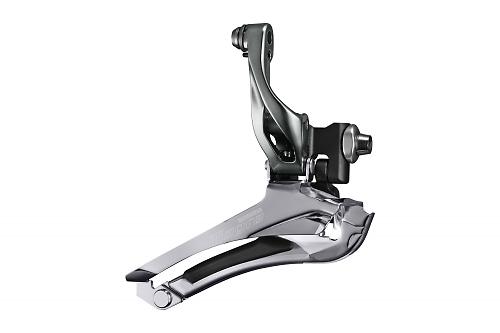
When we reviewed the Shimano 105 groupset we said, “The front mech’s longer, newly shaped link arm creates more leverage and therefore requires less effort to effect the shift. Couple that with a new spring mechanism and the shifting is smooth, fast and precise.”
We found the Tiagra front derailleur to shift cleanly, smoothly and quietly, even under load.
Rear derailleur
Tiagra£37.99 (short cage), £39.99 (long cage)
277g (long cage)
105£47.99 (short cage), £52.99 (long cage)
234g (short cage), 250g (long cage)
The Tiagra and 105 (below) rear derailleurs are very similar, although the Tiagra version is designed to be used as part of a 10-speed setup while the 105 version is designed for 11-speed. Each is made with a bracket body, plate body and plates made from aluminium.
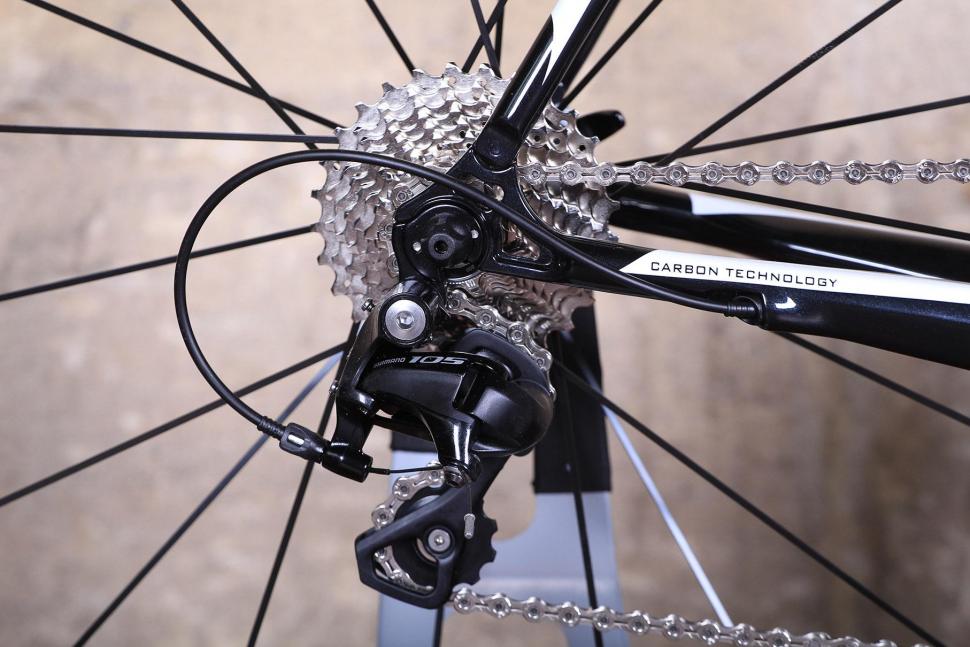
Both Tiagra and 105 rear derailleurs come in short cage and long cage versions for use with different cassettes.
Go for the long cage version of 105 and you can use a largest sprocket with 32 teeth while Tiagra allows you to go to 34-tooth for an even lower gear to help you get up the steepest of climbs.
“The geometry of the 105 rear derailleur has been changed quite a bit [from the previous version of 105] as has the cable pitch,” we said when we reviewed it.
“Thanks to that and the new lighter spring balance the shifting is absolutely spot on. With the bike on the workstand we played a game of seeing how fast we could shift before the mech became flustered but it's safe to say your finger will make a mistake first. Up and down the cassette in a blur goes the chain.”

When we reviewed Tiagra we said, “Shimano says it has revised the cable pitch on the rear derailleur (above), claiming it now offers 'precise and long-lasting shifting performance'. It's certainly living up to those claims compared with old Tiagra.”
Cassette
Tiagra£29.99 (11-25, 11-28), £34.99 (11-32, 11-34)
355g (11-32)
105£49.99 (12-25, 11-28), £54.99 (11-32)
269g (12-25)
The Tiagra and 105 cassettes both feature nickel plated steel sprockets although the 105 version has an a spider arm and a lockring made from anodised aluminium and it’s considerably lighter. The biggest difference, though, is that a 105 cassette is 11-speed while a Tiagra one is 10-speed.
105 is available in 11-25, 11-32 and 12-25 tooth options while Tiagra comes in 11-25, 12-28 11-32 and a very wide ranging 11-34 tooth.
When he reviewed Shimano 105 (above) Stu said, “Resistance to wear has always been a reason for me to buy 105 sprockets even with an Ultegra or Dura-Ace equipped bike, and that remains here as the nickel-plated sprockets are standing up to pretty much anything you can throw at it.
“The shifting is sharp and those computer designed tooth profiles must be doing their job as even under load there were no missed shifts.”
Chain
Tiagra£19.99
273g (114 links)
105 £29.99
257g (114 links)
The 105 chain (below) is 11-speed rather than 10-speed, so it’s narrower and a little lighter than the Tiagra version.

They both run very quietly thanks to Sil-Tec (PTFE) coated links.
Bottom bracket
Tiagra£16.99
92g (threaded), 71g (press-fit)
105£29.99
77g (threaded), 69g (press-fit)

The Tiagra press-fit bottom bracket is nearly as light as the 105 version. Although the threaded model is quite a bit heavier than the 105 one (above) in percentage terms, you’re still only talking about 15g, and that’s negligible considering the overall weight of your bike.
Conclusion
Tiagra is a really impressive groupset. It does everything you want from a mid-level road bike with only a few minor quibbles. The biggest decision is whether you're really fussed about having the 11-speed of Shimano's more expensive 105.
If you go for Tiagra you can’t upgrade to 105 one component at a time because 10-speed and 11-speed drivetrain components aren’t interchangeable – at least not officially. You’d have to upgrade most of the groupset components at once for optimum performance. As well as an 11-speed cassette having an extra sprocket, the spacing between those sprockets is smaller, an 11-speed chain is narrower than a 10-speed chain, the derailleur shift ratios are different and, obviously, an 11-speed shifter has one more position than a 10-speed one.
If you go for 105, on the other hand, you could swap to Ultegra or Dura-Ace gradually as each component wears out. That might be attractive, but only if you’re realistically likely to do this.
If you want really low gears, Tiagra might be the better choice because you can get a cassette with a 34-tooth largest sprocket. The maximum you can have with 105 is 32-tooth.
The other major difference between the two groupsets is that the 105 brakes are considerably better than Tiagra ones. They are a real highlight both in terms of all-out power and fingertip control.
Tiagra offers excellent value for money but 105 is certainly the better groupset and we’d recommend going for it if your funds allow because of the better brakes, the small weight saving and the upgrade to 11-speed.
Struggling on the hills? If you need lower gears to make climbing easier, here's how to get them — and you don't need to spend a fortune to do it
Struggling on the hills? If you need lower gears to make climbing easier, here's how to get them — and you don't need to spend a fortune to do it
Video just in: Giant TCR Advanced 2 Disc
Video just in: Giant TCR Advanced 2 Disc
Cross-chaining: is it really all that bad?
Cross-chaining: is it really all that bad?
Shimano Dura-Ace C24 Carbon Clincher wheelset
Shimano's Dura-Ace C24 carbon laminated wheels are light, stiff and responsive, putting in an excellent all-round performance.
I've been running the C24s with 25mm Continental Grand Prix 4000 tyres (Shimano advises that you use tyres ranging from 23mm to 28mm with these wheels) and they've been very quick, accelerating fast, and the ride quality is hard to fault.
> Find your nearest dealer here
The C24s, which have just been given a graphics/aesthetics update to match Shimano's new R9100 components, have the shallowest rim heights of any wheels in the Dura-Ace range: the front is 21mm and the rear is 24mm. They're not particularly wide either: 15mm internal, 20.8mm external, whereas the new C40 and C60 clinchers are both 17mm internal and 24mm external, following the trend towards more width.
The rims are aluminium alloy with a CFRP (carbon fibre reinforced polymer) laminate on the hub-facing surfaces. The aluminium wall thickness is just 0.7mm and Shimano uses 'a patented phosphoric acid anodising process to bond the carbon fibre rim to the alloy [to ensure] an excellent combination of strength, rigidity and a low weight'.
Our review wheels came in at 601g (front) and 820g (rear), a total of 1,421g (without rim tape or skewers). That's a little higher than Shimano's claimed 1,389g but it's still impressively light, particularly as Shimano hasn't compromised quality or durability here.
The hub shells are aluminium too, with a titanium freehub body at the rear. The wheels spin on cup and cone bearings, as is the Shimano way. The sealed cartridge bearings that most other brands use these days might be fit and forget but Shimano's design allows you to adjust the preload or give the bearings a complete service to ensure optimum performance and maximum longevity... as long as you know what you're doing (if not, you can take them to your local bike shop, of course). The labyrinth double-contact seals have managed to keep the stainless ball bearings running free of water and gunk during a particularly wet and mucky review period.
You get 16 straight-pull butted and bladed spokes in the front wheel and 20, laced two-cross, at the rear. Attached to very widely spaced hub flanges, they provide excellent levels of stiffness that you notice particularly while cornering hard or riding out of the saddle. I only managed to get brake rub when I set the pads stupidly close to the rims and rode uphill in a ridiculously hard gear; in all realistic circumstances there was none at all. The wheels feel taut and efficient.
Braking is up to the standards you'd expect on an aluminium brake track – which means it's better than you get with any carbon fibre rims out there. A few brands, notably Mavic, have improved the quality of carbon fibre braking lately, but none has the bite or consistency that you get with something like the C24 wheelset.
Shimano doesn't make any aerodynamic claims for the C24s. If you're looking to reduce drag you need to step up to the C40s or the C60s. What you do get here is that lightness and responsiveness that I've mentioned and, as you'd expect, a shedload of stability no matter what the wind is doing.
The other point that's worth mentioning here is the ride quality. I'm not a big one for talking about smoothness when it comes to wheels but these do take an appreciable amount of road buzz out of your ride, and that makes a big difference to the way you feel.
> Buyer's Guide: Road bike wheels
These wheels have required no truing during the two-month test period and the titanium freehub is virtually unmarked so it looks like it'll go the distance.
All in all, these are very impressive wheels. They don't have the width of many modern designs, nor the aerodynamics, but they are light and fast reacting, and the alloy brake track adds to their all-weather versatility.
Verdict
Stiff, fast-reacting wheels built to a very high standard and with the reliability of an aluminium brake track
road.cc test report
Make and model: Shimano Dura-Ace C24 Carbon Clincher wheelset
Size tested: 700C
Tell us what the wheel is for, and who it's aimed at. What do the manufacturers say about it? How does that compare to your own feelings about it?
Shimano says: "WH-R9100 CL carbon clincher wheel, designed to meet pro road race criteria"
Tell us some more about the technical aspects of the wheel?
Full carbon / alloy 21 mm deep 20.8 mm wide rim
Low rim weight is achieved by reducing the alloy wall thickness from 1.3 mm down to 0.7 mm, then a patented phosphoric acid anodizing process is used to bond the carbon fibre to the alloy giving an excellent combination of low weight, strength and rigidity
Carbon reinforced spoke eyelets increase durability
Alloy clincher rim maintains high braking performance with standard brake pads in all conditions
Front: 16 stainless steel butted (2.0-1.5-2.0) and bladed straight pull spokes
Rear: 20 stainless steel butted (2.0-1.8-2.0) and bladed straight pull spokes
Elbow-less spokes make for a strong yet compliant wheel
High lateral rigidity is produced with a wide flange spacing
Labyrinth double-contact sealing effectively shuts out water and dirt
Alloy cone with integrated steel Borozon treated bearing races - super mirror finish reduces friction
Quick and easy to maintain digital click bearing adjustment
Cold forged, machined aluminium hub shell and oversized 7075 alloy axle keep the wheel weight to a minimum
700C clincher compatible
Supplied with Q/R skewer
Average weight front: 585g
Average weight rear: 804g
The price has gone up considerably over the Dura-Ace 9000 version of this wheel, but the distributor tells us that's because of currency changes as a result of Brexit.
Did the wheels stay true? Any issues with spoke tension?
They've stayed absolutely true with no need for fettling.
How easy did you find it to fit tyres?
No problems.
How did the wheel extras (eg skewers and rim tape) perform?
Great. The large lever at the end of the quick release is easy to use.
Tell us how the wheel performed overall when used for its designed purpose
It's light, stiff and responsive.
Tell us what you particularly liked about the wheel
The fact that it reacts fast and efficiently.
Tell us what you particularly disliked about the wheel
The price rise is a shame, but that's not unique to Shimano.
Did you enjoy using the wheel? Yes
Would you consider buying the wheel? Yes
Would you recommend the wheel to a friend? Yes
Use this box to explain your score
These put in a strong performance across the board. Yes, the price has gone up considerably in the UK (from £849 to £999), apparently as a result of currency changes, but these are exceptionally good wheels.
About the tester
Age: 43
I usually ride: My best bike is:
I've been riding for: Over 20 years I ride: Most days I would class myself as: Expert
I regularly do the following types of riding: commuting, club rides, sportives, general fitness riding
Stiff, fast-reacting wheels built to a very high standard and with the reliability of an aluminium brake track










